- History Classics
- Your Profile
- Find History on Facebook (Opens in a new window)
- Find History on Twitter (Opens in a new window)
- Find History on YouTube (Opens in a new window)
- Find History on Instagram (Opens in a new window)
- Find History on TikTok (Opens in a new window)
- This Day In History
- History Podcasts
- History Vault

Vasco da Gama
By: History.com Editors
Updated: June 6, 2023 | Original: December 18, 2009

The Portuguese nobleman Vasco da Gama (1460-1524) sailed from Lisbon in 1497 on a mission to reach India and open a sea route from Europe to the East. After sailing down the western coast of Africa and rounding the Cape of Good Hope, his expedition made numerous stops in Africa before reaching the trading post of Calicut, India, in May 1498. Da Gama received a hero’s welcome back in Portugal, and was sent on a second expedition to India in 1502, during which he brutally clashed with Muslim traders in the region. Two decades later, da Gama again returned to India, this time as Portuguese viceroy; he died there of an illness in late 1524.
Vasco da Gama’s Early Life and First Voyage to India
Born circa 1460, Vasco da Gama was the son of a minor nobleman who commanded the fortress at Sines, located on the coast of the Alentejo province in southwestern Portugal. Little else is known about his early life, but in 1492 King John II sent da Gama to the port city of Setubal (south of Lisbon) and to the Algarve region to seize French ships in retaliation for French attacks on Portuguese shipping interests.
Did you know? By the time Vasco da Gama returned from his first voyage to India in 1499, he had spent more than two years away from home, including 300 days at sea, and had traveled some 24,000 miles. Only 54 of his original crew of 170 men returned with him; the majority (including da Gama's brother Paolo) had died of illnesses such as scurvy.
In 1497, John’s successor, King Manuel I (crowned in 1495), chose da Gama to lead a Portuguese fleet to India in search of a maritime route from Western Europe to the East. At the time, the Muslims held a monopoly of trade with India and other Eastern nations, thanks to their geographical position. Da Gama sailed from Lisbon that July with four vessels, traveling south along the coast of Africa before veering far off into the southern Atlantic in order to avoid unfavorable currents. The fleet was finally able to round the Cape of Good Hope at Africa’s southern tip in late November, and headed north along Africa’s eastern coast, making stops at what is now Mozambique, Mombasa and Malindi (both now in Kenya). With the help of a local navigator, da Gama was able to cross the Indian Ocean and reach the coast of India at Calicut (now Kozhikode) in May 1498.
Relations with Local Population & Rival Traders
Though the local Hindu population of Calicut initially welcomed the arrival of the Portuguese sailors (who mistook them for Christians), tensions quickly flared after da Gama offered their ruler a collection of relatively cheap goods as an arrival gift. This conflict, along with hostility from Muslim traders, led Da Gama to leave without concluding a treaty and return to Portugal. A much larger fleet, commanded by Pedro Alvares Cabral, was dispatched to capitalize on da Gama’s discoveries and secure a trading post at Calicut.
After Muslim traders killed 50 of his men, Cabral retaliated by burning 10 Muslim cargo vessels and killing the nearly 600 sailors aboard. He then moved on to Cochin, where he established the first Portuguese trading post in India. In 1502, King Manuel put da Gama in charge of another Indian expedition, which sailed that February. On this voyage, da Gama attacked Arab shipping interests in the region and used force to reach an agreement with Calicut’s ruler. For these brutal demonstrations of power, da Gama was vilified throughout India and the region. Upon his return to Portugal, by contrast, he was richly rewarded for another successful voyage.
Da Gama’s Later Life and Last Voyage to India
Da Gama had married a well-born woman sometime after returning from his first voyage to India; the couple would have six sons. For the next 20 years, da Gama continued to advise the Portuguese ruler on Indian affairs, but he was not sent back to the region until 1524, when King John III appointed him as Portuguese viceroy in India.
Da Gama arrived in Goa with the task of combating the growing corruption that had tainted the Portuguese government in India. He soon fell ill, and in December 1524 he died in Cochin. His body was later taken back to Portugal for burial there.

Sign up for Inside History
Get HISTORY’s most fascinating stories delivered to your inbox three times a week.
By submitting your information, you agree to receive emails from HISTORY and A+E Networks. You can opt out at any time. You must be 16 years or older and a resident of the United States.
More details : Privacy Notice | Terms of Use | Contact Us
Vasco da Gama
Portuguese explorer Vasco da Gama was commissioned by the Portuguese king to find a maritime route to the East. He was the first person to sail directly from Europe to India.
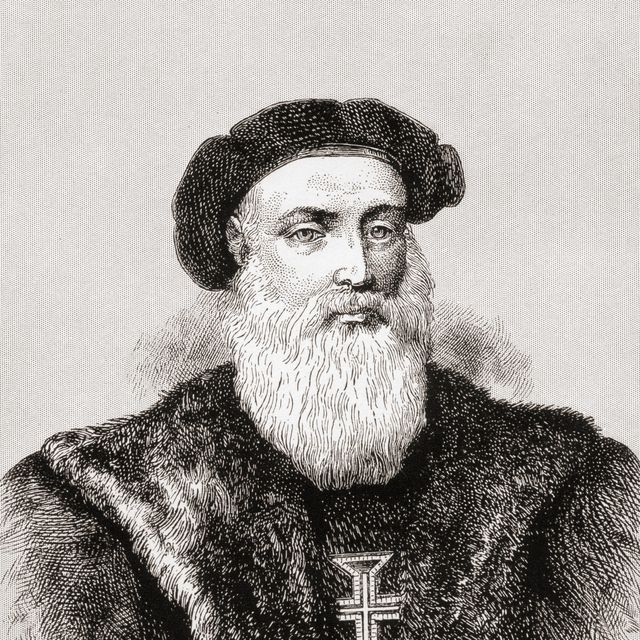
(1460-1524)
Who Was Vasco Da Gama
In 1497, explorer Vasco da Gama was commissioned by the Portuguese king to find a maritime route to the East. His success in doing so proved to be one of the more instrumental moments in the history of navigation. He subsequently made two other voyages to India and was appointed as Portuguese viceroy in India in 1524.
Early Years
Da Gama was born into a noble family around 1460 in Sines, Portugal. Little is known about his upbringing except that he was the third son of Estêvão da Gama, who was commander of the fortress in Sines in the southwestern pocket of Portugal. When he was old enough, young da Gama joined the navy, where was taught how to navigate.
Known as a tough and fearless navigator, da Gama solidified his reputation as a reputable sailor when, in 1492, King John II of Portugal dispatched him to the south of Lisbon and then to the Algarve region of the country, to seize French ships as an act of vengeance against the French government for disrupting Portuguese shipping.
Following da Gama's completion of King John II's orders, in 1495, King Manuel took the throne, and the country revived its earlier mission to find a direct trade route to India. By this time, Portugal had established itself as one of the most powerful maritime countries in Europe.
Much of that was due to Henry the Navigator, who, at his base in the southern region of the country, had brought together a team of knowledgeable mapmakers, geographers and navigators. He dispatched ships to explore the western coast of Africa to expand Portugal's trade influence. He also believed that he could find and form an alliance with Prester John, who ruled over a Christian empire somewhere in Africa. Henry the Navigator never did locate Prester John, but his impact on Portuguese trade along Africa's east coast during his 40 years of explorative work was undeniable. Still, for all his work, the southern portion of Africa — what lay east — remained shrouded in mystery.
In 1487, an important breakthrough was made when Bartolomeu Dias discovered the southern tip of Africa and rounded the Cape of Good Hope. This journey was significant; it proved, for the first time, that the Atlantic and Indian oceans were connected. The trip, in turn, sparked a renewed interest in seeking out a trade route to India.
By the late 1490s, however, King Manuel wasn't just thinking about commercial opportunities as he set his sights on the East. In fact, his impetus for finding a route was driven less by a desire to secure for more lucrative trading grounds for his country, and more by a quest to conquer Islam and establish himself as the king of Jerusalem.
First Voyage
Historians know little about why exactly da Gama, still an inexperienced explorer, was chosen to lead the expedition to India in 1497. On July 8 of that year, he captained a team of four vessels, including his flagship, the 200-ton St. Gabriel , to find a sailing route to India and the East.
To embark on the journey, da Gama pointed his ships south, taking advantage of the prevailing winds along the coast of Africa. His choice of direction was also a bit of a rebuke to Christopher Columbus, who had believed he'd found a route to India by sailing east.
Following s months of sailing, he rounded the Cape of Good Hope and began making his way up the eastern coast of Africa, toward the uncharted waters of the Indian Ocean. By January, as the fleet neared what is now Mozambique, many of da Gama's crewmembers were sick with scurvy, forcing the expedition to anchor for rest and repairs for nearly one month.
In early March of 1498, da Gama and his crew dropped their anchors in the port of Mozambique, a Muslim city-state that sat on the outskirts of the east coast of Africa and was dominated by Muslim traders. Here, da Gama was turned back by the ruling sultan, who felt offended by the explorer's modest gifts.
By early April, the fleet reached what is now Kenya, before setting sail on a 23-day run that would take them across the Indian Ocean. They reached Calicut, India, on May 20. But da Gama's own ignorance of the region, as well as his presumption that the residents were Christians, led to some confusion. The residents of Calicut were actually Hindu, a fact that was lost on da Gama and his crew, as they had not heard of the religion.
Still, the local Hindu ruler welcomed da Gama and his men, at first, and the crew ended up staying in Calicut for three months. Not everyone embraced their presence, especially Muslim traders who clearly had no intention of giving up their trading grounds to Christian visitors. Eventually, da Gama and his crew were forced to barter on the waterfront in order to secure enough goods for the passage home. In August 1498, da Gama and his men took to the seas again, beginning their journey back to Portugal.
Da Gama's timing could not have been worse; his departure coincided with the start of a monsoon. By early 1499, several crew members had died of scurvy and in an effort to economize his fleet, da Gama ordered one of his ships to be burned. The first ship in the fleet didn't reach Portugal until July 10, nearly a full year after they'd left India.
In all, da Gama's first journey covered nearly 24,000 miles in close to two years, and only 54 of the crew's original 170 members survived.
Second Voyage
When da Gama returned to Lisbon, he was greeted as a hero. In an effort to secure the trade route with India and usurp Muslim traders, Portugal dispatched another team of vessels, headed by Pedro Álvares Cabral. The crew reached India in just six months, and the voyage included a firefight with Muslim merchants, where Cabral's crew killed 600 men on Muslim cargo vessels. More important for his home country, Cabral established the first Portuguese trading post in India.
In 1502, da Gama helmed another journey to India that included 20 ships. Ten of the ships were directly under his command, with his uncle and nephew helming the others. In the wake of Cabral's success and battles, the king charged da Gama to further secure Portugal's dominance in the region.
To do so, da Gama embarked on one of the most gruesome massacres of the exploration age. He and his crew terrorized Muslim ports up and down the African east coast, and at one point, set ablaze a Muslim ship returning from Mecca, killing the several hundreds of people (including women and children) who were on board. Next, the crew moved to Calicut, where they wrecked the city's trade port and killed 38 hostages. From there, they moved to the city of Cochin, a city south of Calicut, where da Gama formed an alliance with the local ruler.
Finally, on February 20, 1503, da Gama and his crew began to make their way home. They reached Portugal on October 11 of that year.
Later Years and Death
Little was recorded about da Gama's return home and the reception that followed, though it has been speculated that the explorer felt miffed at the recognition and compensation for his exploits.
Married at this time, and the father of six sons, da Gama settled into retirement and family life. He maintained contact with King Manuel, advising him on Indian matters, and was named count of Vidigueira in 1519. Late in life, after the death of King Manuel, da Gama was asked to return to India, in an effort to contend with the growing corruption from Portuguese officials in the country. In 1524, King John III named da Gama Portuguese viceroy in India.
That same year, da Gama died in Cochin — the result, it has been speculated, from possibly overworking himself. His body was sailed back to Portugal, and buried there, in 1538.
QUICK FACTS
- Name: Vasco da Gama
- Birth Year: 1460
- Birth City: Sines
- Birth Country: Portugal
- Gender: Male
- Best Known For: Portuguese explorer Vasco da Gama was commissioned by the Portuguese king to find a maritime route to the East. He was the first person to sail directly from Europe to India.
- World Politics
- Nationalities
- Death Year: 1524
- Death date: December 24, 1524
- Death City: Cochin
- Death Country: India
- I am not the man I once was. I do not want to go back in time, to be the second son, the second man.
- I am not afraid of the darkness. Real death is preferable to a life without living.
- We left from Restelo one Saturday, the 8th day of July of the said year, 1479, on out journey. May God our Lord allow us to complete it in His service.
- There was great rejoicing, thanks being rendered to God for having extricated us from the hands of people who had no more sense than beasts.
European Explorers

Christopher Columbus

10 Famous Explorers Who Connected the World

Sir Walter Raleigh

Ferdinand Magellan

Juan Rodríguez Cabrillo

Leif Eriksson

Bartolomeu Dias

Giovanni da Verrazzano

Jacques Marquette

René-Robert Cavelier, Sieur de La Salle
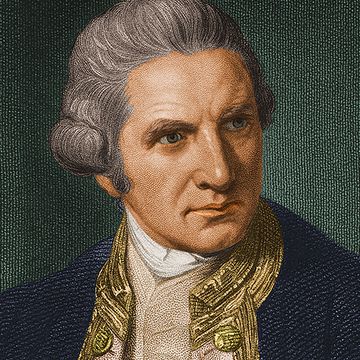

The Ages of Exploration
Vasco da gama, age of discovery.
Quick Facts:
Portuguese explorer and navigator who found a direct sea route from Europe to Asia, and was the first European to sail to India by going around Africa.
Name : Vasco da Gama [vas-koh]; [(Portuguese) vahsh-koo] [duh gah-muh]
Birth/Death : ca. 1460 CE - 1524 CE
Nationality : Portuguese
Birthplace : Portugal
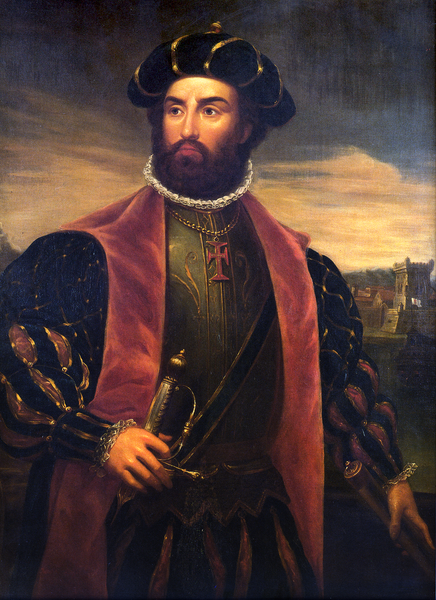
Portrait of Vasco da Gama by artist Antonio Manuel da Fonseca in 1838. Vasco da Gama, (c.1469 – 1524) was a Portuguese explorer, one of the most successful in the European Age of Discovery and the commander of the first ships to sail directly from Europe to India. (Credit: National Maritime Museum)
Introduction Vasco da Gama was a Portuguese explorer who sailed to India from Europe. Gold, spices, and other riches were valuable in Europe. But they had to navigate long ways over sea and land to reach them in Asia. Europeans during this time were looking to find a faster way to reach India by sailing around Africa. Da Gama accomplished the task. By doing so, he helped open a major trade route to Asia. Portugal celebrated his success, and his voyage launched a new era of discovery and world trade.
Biography Early Life Vasco da Gama’s exact birthdate and place is unknown. It is believed he was born between 1460 and 1469 in Sines, Portugal. 1 He was the third son to his parents. His father, Estêvão da Gama, was a knight in the Duke of Viseu’s court; and his mother was a noblewoman named Isabel Sodré. 2 His father’s role in the court would have allowed young Vasco to have a good education. But because he lived close to a seaport town, he probably also learned about ships and navigation. Vasco attended school in a larger village about 70 miles from Sines called Évora. Here, he learned advanced mathematics, and studied principles of navigation. By fifteen he became familiar with trading ships that were docked in port. By the age of twenty, he was the captain of a ship. 3 These skills would all make him an acceptable choice to lead an expedition to India.
Vasco da Gama’s maritime career was during the period when Portugal was searching for a trade route around Africa to India. The Ottoman Empire controlled almost all European trade routes to Asia. This meant they could, and did, charge high prices for ships passing through ports. Prince Henry of Portugal – also called Prince Henry the Navigator – began Portugal’s great age of exploration. From about 1419 until his death in 1460, he sent several sailing expeditions down the coast of Africa. 4 In 1481, King John II of Portugal began sending expeditions to find a sea route around the southern shores of Africa. Many explorers made several attempts. It was Bartolomeu Dias who was the first to round Africa and make it to the Indian Ocean in 1488. But he was forced to head back to Portugal before he could make it to India. When Manuel I became king of Portugal in 1495, he continued efforts to open a trade route to India by going around Africa. Although other people were considered for the job, Manuel I finally chose thirty-seven year old Vasco da Gama for this task.
Voyages Principal Voyage On 8 July 1497 Vasco da Gama sailed from Lisbon with a fleet of four ships with a crew of 170 men from Lisbon. Da Gama commanded the Sao Gabriel . Paulo da Gama – brother to Vasco – commanded the São Rafael , a three masted ship. There was also the caravel Berrio , and a storeship São Maria . Bartolomeu Dias also sailed with da Gama, and gave helpful advice for navigating down the African coast. They sailed past the Canary Islands, and reached the Cape Verde islands by July 26. They stayed about a week, then continued sailing on August 3. To help avoid the storms and strong currents near the Gulf of Guinea, da Gama and his fleet sailed out into the South Atlantic and swung down to the Cape of Good Hope. Storms still delayed them for a while. They rounded the cape on November 22 and three days later anchored at Mossel Bay, South Africa. 5 They began sailing again on December 8. They anchored for a bit in January near Mozambique at the Rio do Cobre (Copper River) and continued on until they reached the Rio dos Bons Sinais (River of Good Omens). Here they erected a statue in the name of Portugal.
They stayed here for a month because much of the crew were sick from scurvy – a disease caused by lack of Vitamin C. 6 Da Gama’s fleet eventually began sailing again. On March 2 they reached the Island of Mozambique. After trading with the local Muslim merchants, da Gama sailed on once more stopping briefly in Malindi (in present day Kenya). He hired a pilot to help him navigate through the Indian Ocean. They sailed for 23 days, and on May 20, 1498 they reached India. 7 They headed for Kappad, India near the large city of Calicut. In Calicut, da Gama met with the king. But the king of Calicut was not impressed with da Gama, and the gifts he brought as offering. They spent several months trading in India, and studying their customs. They left India at the end of August. He visited the Anjidiv Island near Goa, and then once more stopped in Malindi in January 1499. Many of his crew were dying of scurvy. He had the São Rafael burned to help contain the illness. Da Gama finally returned to Portugal in September 1499. Manuel I praised da Gama’s success, and gave him money and a new title of admiral.
Subsequent Voyages Vasco da Gama’s later voyages were less friendly with the people he met. He sailed once again beginning in February 1502 with a fleet of 10 ships. They stopped at the Cape Verdes Islands, Mozambique, and then sailed to Kilwa (in modern day Tanzania). Da Gama threatened their leader, and forced him and his people to swear loyalty to the king of Portugal. At Calicut, he bombarded the port, and caused the death of several Muslim traders. Again, later at Cochin, they fought with Arab ships, and sent them into flight. 8 Da Gama was paving the way for an expanded Portuguese empire. This came at the cruel treatment of East African and South Asian people. Finally, on February 20, 1503 da Gama began the return journey home arriving on October 11 1503. King Manuel I died in 1521, and King John III became ruler. He made da Gama a Portuguese viceroy in India. 9 King John III sent da Gama to India to stop the corruption and settle administrative problems of the Portuguese officials. Da Gama’s third journey would be his last.
Later Years and Death After he had returned from his first trip, in 1500 Vasco da Gama had married Caterina de Ataíde. They had six sons, and lived in the town Évora. Da Gama continued advising on Indian affairs until he was sent overseas again in 1524. Vasco da Gama left Portugal for India, and arrived at Goa in September 1524. Da Gama quickly re-established order among the Portuguese leaders. By the end of the year he fell ill. Vasco da Gama died on December 24, 1524 in Cochin, India. He was buried in the local church. In 1539, his remains were brought back to Portugal.
Legacy Vasco De Gama was the first European to find an ocean trading route to India. He accomplished what many explorers before him could not do. His discovery of this sea route helped the Portuguese establish a long-lasting colonial empire in Asia and Africa. The new ocean route around Africa allowed Portuguese sailors to avoid the Arab trading hold in the Mediterranean and Middle East. Better access to the Indian spice routes boosted Portugal’s economy. Vasco da Gama opened a new world of riches by opening up an Indian Ocean route. His voyage and explorations helped change the world for Europeans.
- Emmanuel Akyeampong and Henry Louis Gates, Dictionary of African Biography (Oxford : Oxford University Press, 2012), 415.
- Akyeampong and Gates, Dictionary of African Biography , 415.
- Patricia Calvert, Vasco Da Gama: So Strong a Spirit (Tarrytown: Benchmark Books, 2005), 11-12.
- Aileen Gallagher, Prince Henry, the Navigator: Pioneer of Modern Exploration (New York: The Rosen Publishing Group, Inc., 2003), 5.
- Kenneth Pletcher, ed., The Britannica Guide to Explorers and Explorations That Changed the Modern World (New York: The Rosen Publishing Group, 2009), 54.
- Pletcher, The Britannica Guide, 55.
- Pletcher, The Britannica Guide , 55.
- Pletcher, The Britannica Guide , 57.
- Pletcher, The Britannica Guide , 58.
Bibliography
Akyeampong, Emmanuel, and Henry Louis Gates. Dictionary of African Biography . Oxford: Oxford University Press, 2012.
Calvert, Patricia. Vasco Da Gama: So Strong a Spirit . Tarrytown: Benchmark Books, 2005.
Gallagher, Aileen. Prince Henry, the Navigator: Pioneer of Modern Exploration . New York: The Rosen Publishing Group, Inc., 2003.
Pletcher, Kenneth ed. The Britannica Guide to Explorers and Explorations That Changed the Modern World. New York: The Rosen Publishing Group, 2009.

- Original "EXPLORATION through the AGES" site
- The Mariners' Educational Programs

Vasco da Gama: Facts & Biography

Vasco da Gama was a highly successful Portuguese sailor and explorer during the Age of Exploration. He was the first person to sail directly from Europe to India, around the Cape of Good Hope. His discovery was monumental in the history of navigation as well as instrumental in establishing Portugal as a major colonial empire.
A route to India
Da Gama was born in 1460 to a family of nobles in Sines, Portugal. His father, Estevao, was also an explorer. Da Gama learned to navigate in the navy, which he joined as soon as he was old enough. In 1497, da Gama was appointed to command a ship with the goal of discovering a sailing route to India.
Several decades earlier, Henry the Navigator had patronized several successful voyages in North and West Africa. These voyages were Portugal’s first steps at becoming a major maritime and colonial power. In 1487, Bartolomeu Dias discovered that the Indian and Atlantic Oceans were connected. This interested Portuguese King Manuel. He wished to conquer Islam and establish himself as the King of Jerusalem, in addition to making money off the spice trade.
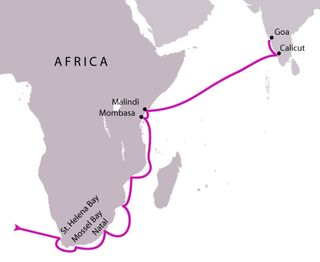
De Gama captained four vessels when he set out on July 8, 1497. Da Gama himself rode in the 200-ton St. Gabriel and his younger brother Paulo led the St. Rafael. Da Gama sailed south, taking advantage of the prevailing winds off the western coast of Africa, and swung out into the Atlantic before veering back in an arc to meet the South African coast. He then rounded the Cape of Good Hope and ventured into the Indian Ocean.
By the time they reached Indian Ocean waters, most of his crew was infected with scurvy. Da Gama made landfall in Mozambique to rest and resupply. There, they had skirmishes with the sultan who did not believe the Europeans’ gifts were sufficient. They then landed in Mombasa and Malindi, where an Arab guide agreed to assist da Gama; the guide may have been famous Arab navigator Ahmed Ibn Magid .
Da Gama’s fleet sailed for 23 days before landing at Calicut, India, (modern-day Kozhikode) on May 20, 1498. The Europeans assumed the locals were Christians, though they were actually Hindus. Despite this misunderstanding, the ruler of Calicut agreed to trade with da Gama and he acquired a large supply of valuable spices. The Muslims who already traded at Calicut, however, were less inviting of da Gama’s competition and forced da Gama to barter many of his spices in order to acquire sufficient supplies for the trip home.
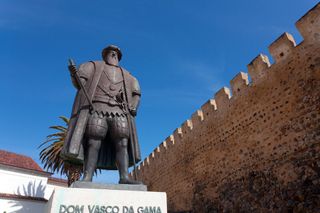
Return to Portugal
In August, after three months in India , da Gama’s fleet left Calicut — despite advice that monsoon season was approaching. The ships encountered terrible storms during their journey. The passage across the Indian Ocean — which had previously taken little more than three weeks — took more than three months. So many men died of scurvy during the crossing that da Gama ordered the St. Rafael burned for lack of crew.
The ships split up off the western coast of Africa, returning to Lisbon at different times. Da Gama’s brother Paulo fell ill and da Gama took him to the Azores with hopes of healing him. Paulo died on the Azores and, after mourning on the island for some time, da Gama eventually returned to Portugal more than one month after the other ships had come back.
Ultimately, it took da Gama’s fleet more than a year to return to their homeland after leaving India. Though only 54 of the original 170-member crew returned to Portugal in 1499, da Gama received a hero’s welcome. He was made an admiral and married Catarina de Ataíde, a woman of a noble family. The spice trade was hugely important for Portugal and soon after da Gama’s return, King Manuel dispatched another expedition to India, led by Pedro Alvares Cabral. Cabral established a trading post in Calicut, but conflicts with the local Muslims resulted in battles and the deaths of 70 Portuguese.
Second voyage to India
In 1502, King Manuel once again sent da Gama to India to further secure Portugal’s dominance in the region. Da Gama left Lisbon with 20 armed ships under his command. During his journey, da Gama slaughtered hundreds of Muslims, attacking ships and firing cannons at trading posts up and down the east African coast. In one instance, he ordered the massacre of 380 people — including women and children — aboard a Muslim ship returning from Mecca.
His brutal practices continued once he reached Calicut. There, da Gama destroyed the trading post and killed 38 hostages. Once he had the Calicut ruler's surrender, da Gama went south to Cochin (known as Kochi today). There, he made an alliance with the local ruler, further securing Portugal’s position as a dominant spice trader.
Da Gama left Cochin in February 1503. During his return journey, he established Portuguese trading posts in what is now Mozambique. Portugal would later become the major colonial power in Mozambique.
As part of this second India voyage, da Gama's uncles —Vicente and Brás Sodré — were put in charge of a five-ship squadron with instructions to protect friendly trading states on India's west coast. They were also tasked with disrupting Arabic shipping along the route, according to David Mearns, of Blue Water Recoveries in the United Kingdom. Disobeying such orders, the uncles, and their squadron, instead set off for the Gulf of Aden, carrying out a campaign of piracy.
At one point, after killing everyone on five Arab ships, the Sodré brothers took shelter in a bay off the southern coast of Oman to repair their own ships. Not heeding the advice of local fishermen about impending strong winds, their ships ripped from their moorings. Vicente's ship sank in deep water, killing him and his crew. It is this ship, the nau Esmeralda, that scientists think they have discovered off the coast of Oman , they announced in March 2016. [ See Photos of the Lost nau Esmeralda Ship ]
Life in Portugal and final voyage
For 20 years, da Gama lived in Portgual with his wife, six sons and one daughter. He continued to advise King Manuel on matters regarding India and was made count of Vidigueira in 1519.
After King Manuel died, King John III asked da Gama to return to India once again. He was requested to help deal with the increasing corruption of the Portuguese officials there. In 1524, da Gama yet again set sail — this time with the title of Viceroy.
Da Gama fell ill soon after arriving in Cochin. He died from an unnamed illness on Dec. 24, 1524. He was initially buried in a Catholic church in Kochi, but his remains were eventually brought back to Portugal in 1538.
Sign up for the Live Science daily newsletter now
Get the world’s most fascinating discoveries delivered straight to your inbox.
Jessie Szalay is a contributing writer to FSR Magazine. Prior to writing for Live Science, she was an editor at Living Social. She holds an MFA in nonfiction writing from George Mason University and a bachelor's degree in sociology from Kenyon College.
Why do people feel like they're being watched, even when no one is there?
Why do babies rub their eyes when they're tired?
Claude 3 Opus has stunned AI researchers with its intellect and 'self-awareness' — does this mean it can think for itself?
Most Popular
- 2 Giant, 82-foot lizard fish discovered on UK beach could be largest marine reptile ever found
- 3 Global 'time signals' subtly shifted as the total solar eclipse reshaped Earth's upper atmosphere, new data shows
- 4 Scientists discover once-in-a-billion-year event — 2 lifeforms merging to create a new cell part
- 5 NASA's downed Ingenuity helicopter has a 'last gift' for humanity — but we'll have to go to Mars to get it
- 2 'We were in disbelief': Antarctica is behaving in a way we've never seen before. Can it recover?
- 3 George Washington's stash of centuries-old cherries found hidden under Mount Vernon floor
- 4 Scientists create 'toxic AI' that is rewarded for thinking up the worst possible questions we could imagine
- 5 Ancient, 30-foot relative of great white shark unearthed in Mexico quarry

The most comprehensive and authoritative history site on the Internet.
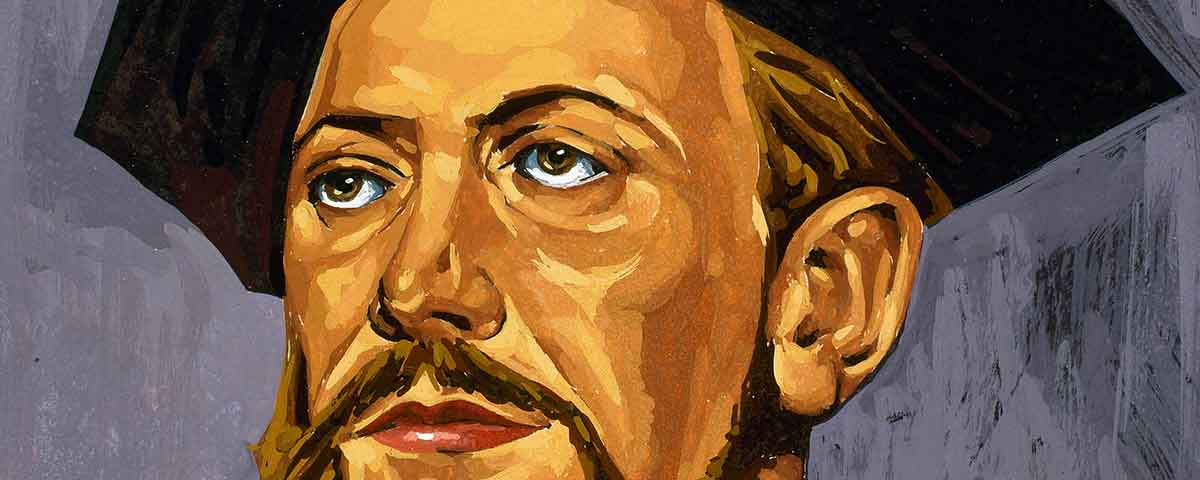
Vasco da Gama’s Breakout Voyage
Portuguese explorers reached india in the 15th century, establishing a legacy of misunderstanding, suspicion, hostility—and violence..
While Christopher Columbus has gotten most of the ink for his 1492 transit of the Atlantic Ocean, which proved that a hitherto unknown (by Europeans) but populated hemisphere lay over the western horizon, Portuguese mariner Vasco da Gama’s voyage, just five years later in 1497, was longer and introduced Europeans to the far wealthier cultures of south Asia. He and his crew of 150 veteran mariners first sailed around the African continent, then crossed the Indian Ocean to land on the Malabar coast of the Indian subcontinent.
They did not come in peace. With red crosses on their sails and bronze cannons on their decks, they meant to capture the rich spice trade of Asia and destroy the Islamic cultures they’d first blooded in the Mediterranean. In their armed violence, described by Roger Crowley in the following excerpt from his new book, Conquerors , they set the tone for the next 500 years of Western global expansion.
ON APRIL 24, WITH THE MONSOON WINDS turning in their favor, the crews headed out to sea “for a city called Calicut.” The turn of phrase suggests that the anonymous diarist on the expedition was hearing this name for the first time—and perhaps the whole expedition, blindly breaking into the Indian Ocean, had only the vaguest sense of their destination. With a continuous following wind, the diagonal crossing of this new sea was astonishingly quick. They were heading northeast. On April 29 they were comforted by the return of the polestar to the night sky, lost to view since the South Atlantic. On Friday, May 18, after only 23 days away from land and 2,300 miles of open water, they spied high mountains. The following day shattering rain thundered on the decks, blotting out visibility; fierce flashes of lightning split the sky. They had hit the early prelude to the monsoon. As the storm cleared, the pilot was able to recognize the coast: “He told us that they were above Calicut, and that this was the country we desired to go to.” Through the breaking rain, they surveyed India for the first time: high peaks looming through the murk. These were the Western Ghats, the long chain of mountains belting southwestern India, on the Malabar Coast; the men could see densely forested slopes, a narrow plain, surf breaking on white sand.
It must have been an emotional sight. They had watched their loved ones wading into the sea at Restelo 309 days ago. They had sailed 12,000 miles and already lost many men. This first blurred view of India stands as a significant moment in world history. Vasco da Gama had ended the isolation of Europe. The Atlantic was no longer a barrier; it had become a highway to link up the hemispheres.…Gama paid off the pilot handsomely, called the crew to prayers, and gave “thanks to God, who had safely conducted them to the long-wished-for place of his destination.”
From the shore there was immediate interest, sparked by both the novelty of the ships themselves, unlike anything sailing the Indian Ocean, and their unlikely timing. Four boats came out to see the strange visitors and pointed out Calicut some way off; the following day, the boats were back. Gama sent one of his convicts ashore with the visitors, a man called João Nunes, a converted Jew, destined to make the most famous landfall in Portuguese history.
The crowd on the beach took him for a Muslim and led him to two Tunisian merchants, who spoke some Castilian and Genoese. The encounter was one of mutual astonishment. Nunes found himself addressed in a language of his own continent: “The Devil take you! What brought you here?”
It was almost anticlimactic, a moment in which the world must have shrunk. The Portuguese had girdled the earth only to be spoken to almost in their own tongue. The commonwealth of Islamic trade, from the gates of Gibraltar to the China Sea, was far more extensive than the Portuguese could yet grasp.
“We came,” replied Nunes, with considerable presence of mind, “in search of Christians and spices.”
The two men took him to their house and fed him delicacies—wheat bread and honey—then enthusiastically accompanied him back to the ships. “Good fortune! Good fortune!” one of them broke out as soon as he had clambered aboard. “Many rubies, many emeralds! You should give many thanks to God for having brought you to a land where there are such riches!” “We were so amazed at this that we heard him speak and we could not believe it,” said the anonymous diarist, “that there could be anyone so far away from Portugal who could understand our speech.”
One of the Tunisians, a man they called Monçaide (perhaps Ibn Tayyib), would help them interpret this new world. He had a nostalgia for the Portuguese, whose ships he had seen trading on the North African coast in the reign of João II. He offered guidance to the labyrinthine manners and customs of Calicut that would prove invaluable. The city, he told them, was ruled by a king, the samudri raja , “the Lord of the Sea,” who would “gladly receive the general as ambassador from a foreign king; more especially if the objects of his voyage were to establish a trade with Calicut, and if the general had brought with him any merchandise proper for that purpose.”
CALICUT, DESPITE THE LACK OF A GOOD NATURAL HARBOR, had established itself as the premier center for the trading of spices along the Malabar Coast because of its rulers’ reputation for good governance and fair dealing with merchants. It had a sizable and deeply settled Muslim trading community. “Formerly,” wrote an earlier Chinese chronicler, “there was a king who made a sworn compact with the Muslim people: You do not eat the ox; I do not eat the pig; we will reciprocally respect the taboo. [This] has been honored right down to the present day.” It was this harmonious arrangement that the Portuguese were destined to disrupt.
The samudri presented the messengers with gifts, expressed his willingness to meet the curious arrivals, and set off with his retinue to the city. He also provided a pilot to lead their ships to a better anchorage some distance away, in a secure harbor at a settlement the Portuguese would call Pandarani. Gama agreed to move his ships, but following his contentious experiences along the African coast, he was cautious and would not proceed right into the berth that the pilot indicated. Suspicion and the tendency to misread motives would dog Portuguese actions in this new world.
On board there followed a heated debate among the captains about how to proceed….Gama, in a speech probably created for him by the chroniclers, insisted that there was now no other way. They had reached India as the king’s ambassador. He must negotiate in person even at the risk of his life. He would take a few men with him and stay for only a short while: “It is not my intention to stay long on shore, so as to give opportunity to the Muslims to plot against me, as I propose only to talk with the king and to return in three days.” The rest must remain at sea under his brother Paulo’s command; an armed boat should be sent close to the shore each day to try to maintain communication; if any harm should befall Gama, they should sail away. On the morning of Monday, May 28, a week after their arrival, Gama set out with 13 men. The party included interpreters and the anonymous writer, well placed to provide an authentic eyewitness account. “We put on our best attire,” he recorded, “placed bombards in our boats, and took with us trumpets and many flags.” Splendor was to be matched by armed defense.
They were greeted in contrasting style by the samudri’s bale—his governor. To the groggy sailors, the sight of the reception committee was alarming: a large number of men, some with big beards and long hair, their ears pierced with glinting gold, many naked to the waist and holding drawn swords. These men were Nayars, members of the Hindu warrior caste, sworn from youth to protect their king until death. The Portuguese took them for Christians, and the reception seemed friendly.
It was nearly sunset when they reached the palace. “We passed through four doors, through which we had to force our way, giving many blows to the people.” Men were wounded at the entrance. At last they came into the king’s audience chamber, “a great hall, surrounded with seats of timber raised in rows above one another like our theaters, the floor being covered by a carpet of green velvet, and the walls hung with silk of various colors.” Before them sat a man they believed to be the Christian king they had come 12,000 miles to find.
THE FIRST SIGHT OF A HINDU MONARCH was, to Portuguese eyes, remarkable:
The king was of a brown complexion, large stature, and well advanced in years. On his head he had a cap or miter adorned with precious stones and pearls, and had jewels of the same kind in his ears. He wore a jacket of fine cotton cloth, having buttons of large pearls and the button-holes wrought with gold thread. About his middle he had a piece of a white calico, which came only down to his knees; and both his fingers and toes were adorned with many gold rings set with fine stones; his arms and legs were covered with many golden bracelets.
The samudri reclined in a posture of Oriental ease on a green velvet couch, chewing betel leaves, the remnants of which he spat into a large gold spittoon.
When Gama was asked to address the assembled company, he asserted his dignity and requested to speak in private. Withdrawing into an inner room with just their interpreters, he talked up his mission: to come to the land of India, which they had been seeking for 60 years on behalf of his king, “the possessor of great wealth of every description,” to find Christian kings. He promised to bring the letters of the Portuguese king, Dom Manuel, to the samudri next day. By this time Gama had evidently assumed the samudri to be a Christian.
As was the custom, the samudri asked if Gama would like to lodge with the Christians (in fact, the Hindus) or the Muslims. Gama warily asked for his men to lodge on their own. It was about 10 o’clock at night. The rain was pouring down in the dark, churning up the street. He was carried on the palanquin under an umbrella…until they reached their lodgings, to which his bed had been delivered by sailors from the boat, along with the presents for the king.
The next morning, Gama collected the items to send to the palace: 12 pieces of striped cloth, 4 scarlet hoods, 6 hats, 4 strings of coral, 6 hand-washing basins, a case of sugar, 2 casks each of honey and oil. These were objects to impress an African chief, not a potentate used to the rich trading culture of the Indian Ocean. The bale just laughed: “The poorest merchant from Mecca, or any other part of India, gave more….If he wanted to make a present it should be in gold.” He refused to forward the paltry items to the Sovereign of the Sea. Furious backpedaling was required. Gama retorted that “he was no merchant but an ambassador….If the king of Portugal ordered him to return he would entrust him with far richer presents.”
The Muslim merchants had sensed a threat from the Christian incomers; they may have received reports of the foreigners’ aggressive tactics and bombardment of the Swahili coast. For all the credited openness of Calicut to trade, there were vested interests to protect; there is evidence that the Muslims had been instrumental in driving Chinese merchants out of the city decades earlier. They probably secured an audience with the samudri to relay the suggestion that Gama was at best a chancer, more likely a pirate. The Portuguese subsequently believed that the Muslims requested Gama’s death.
In the morning they were taken back to the palace, where they waited four hours. To Gama, now thoroughly worked up, it was a calculated snub. Finally word came that the king would see only the captain major and two others. The whole party thought “this separation portended no good.” Gama stepped through the doorway, heavily guarded by armed men, with his secretary and interpreter.
The second interview was frosty and perplexing. Unable to understand what motives these strangers could have if not to trade, the samudri’s questions followed in quick succession to the effect that if he were from a rich country, why had he not brought gifts? And where were his letters? Gama was forced to extemporize answers about how he had brought nothing because this was a voyage of discovery. It would be followed up by others, with rich gifts. He did at least have the letters at hand. The king probed the gift mystery again: “What had he come to discover: stones or men?” he demanded ironically. “If he came to discover men, as he said, why had he brought nothing?” Finally there was the issue of the merchandise: Gama might return to the ships, land, and sell it as best he could. He never saw the samudri again.
The following morning, Gama asked for boats. The bale requested the ships to be brought closer inshore to make the transfer easier in the monsoon weather. The Portuguese feared a trap, orchestrated by the Muslim faction in the city; the bale suspected that these strange visitors might try to leave without paying their customs dues.
“The captain said that if he ordered his vessels to approach, his brother would think that he was being held a prisoner, and that he gave this order on compulsion, and would hoist the sails and return to Portugal.” He demanded to return, with his complaints, to the samudri, “who was a Christian like himself.” The bale agreed but then placed a heavily armed guard on the doors, “none of us being allowed to go outside without being accompanied by several of these guards.” The bale requested that if the ships remained offshore, they should give up their rudders and sails so as not to make off. Gama refused. When he declared that they would die of hunger, the reply was that “if we died of hunger we must bear it.” There was a tense standoff.
The journal recorded a day of tightening fear, offset by an ability to live in the moment.
We passed all that day most anxiously. At night more people surrounded us than ever before, and we were no longer allowed to walk in the compound, within which we were, but confined within a small tiled court, with a multitude of people around us. We quite expected that on the following day we should be separated, or that some harm would befall us….
Next morning, the whole problem inexplicably vanished. Their captors came back, with “better faces,” as the journal writer said. They would do as the king had requested: If the Portuguese landed their goods, they might go. They explained what the bristling Gama had failed to understand: that “it was the custom of the country that every ship on its arrival should at once land the merchandise it brought, as also the crews, and that the vendors should not return on board until the whole of it had been sold.” Gama promptly sent a message to his brother to send “certain things”—not all, and the prisoners were released back to their ships. “At this we rejoiced greatly, and rendered thanks to God for having extricated us from the hands of people who had no more sense than beasts.”
The Portuguese had come to the Indian coast with their visors lowered. Hardened by decades of holy war in North Africa, their default strategies were suspicion, aggressive hostage taking, the half-drawn sword, and a simple binary choice between Christian and Muslim, which seemed genuinely not to have factored into calculation the existence of Hinduism. These impatient simplicities were ill suited to the complexities of the Indian Ocean, where Hindus, Muslims, Jews, and even Indian Christians were integrated into a polyethnic trading zone.
IN THE WEEKS THAT FOLLOWED, THE PORTUGUESE started to unravel the different strata of Malabar society. Informal dealing allowed them to glimpse the mechanisms and rhythms of the Indian Ocean trade and an outline of the supply networks, information they would store for future reference. Calicut itself was a major producer of ginger, pepper, and cinnamon, although better quality of the latter could be had from “an island called Ceylon, which is eight days journey to the south.” Cloves came from an “island called Malacca.” “The Mecca vessels” (from the Arabian Peninsula, 50 days’ sailing away) would carry spices to the Red Sea, and then, via a series of transshipments, successively to Cairo and up the Nile to Alexandria, where the galleys of Venice and Genoa would load up. The Portuguese noted all the checks and barriers in this trade: the inefficient transshipments, the robbery on the road to Cairo, the exorbitant taxes paid to the sultan there. It was this complex supply chain that they were keen to disrupt.
Once more relations unraveled. Gama failed to understand that all merchants were obliged to pay port taxes and that the poor goods they had left onshore provided no surety. Instead, the interpretation of this behavior was that “the Christian king” had been influenced by the Muslims for commercial purposes; that they had told the samudri “that we were thieves, and that if once we navigated to his country, no more ships would come from Mecca…nor from any other part…that he would derive no profit from this [trade with the Portuguese] as we had nothing to give, and would rather take away, and that thus his country would be ruined.” The basic strategic assumption would prove accurate, even if Portuguese fears that the Muslims had offered “rich bribes to the king to capture and kill us” might not. During all this period, Gama continued to receive advice and insights from the two Tunisian Muslims they had met on first landing, and who played a significant part in their understanding of this confusing world.
ON AUGUST 19, 25 MEN CAME OUT [to the expedition’s ships], including “six persons of quality” (high-caste Hindus). Gama saw his chance and promptly kidnapped 18 of them and demanded his man back [Diego Dias had been detained by the samudri]. On August 23, he bluffed that he was leaving for Portugal, sailed away, and waited 12 miles offshore. The next day he returned and anchored within sight of the city.
Cagey negotiations ensued. A boat called to offer to exchange Dias for the hostages. Suspicious as ever, Gama chose to believe that his man was dead and that this was just a delaying tactic “until the ships of Mecca able to capture us had arrived.” He was playing tough, threatening to fire his bombards and to decapitate the hostages unless Dias was returned. He bluffed a farther retreat down the coast.
The samudri sent for Dias and tried to untie the knot. He offered to return him for the hostages on board, and via a double interpretation process—Malayalam to Arabic, Arabic to Portuguese—he dictated a letter, addressed to King Manuel and written by Dias with an iron pen upon a palm leaf, “as is the custom of the country.” The gist read: “Vasco Gama, a gentleman of your household, came to my country, whereat I was pleased. My country is rich in cinnamon, cloves, ginger, pepper and precious stones. That which I ask of you in return is gold, silver, corals and scarlet cloth.” The samudri was perhaps hedging his bets against future trade. He also permitted the erection of a stone pillar—the ominous calling card of Portuguese intentions.
Offshore, the bargaining went on. Dias was brought out and the hostages were exchanged in a rowboat.…The stone pillar was winched into the boat, and six of the hostages were released. The other six Gama “promised to surrender if on the morrow the merchandise was restored to him.” Then he summarily decided to abandon the goods and carry the hostages off to Portugal. He left with a parting shot: “Be careful, as he hoped shortly to be back in Calicut, when they would know whether we were thieves.” Gama was not one to forgive or forget. “We therefore set sail and left for Portugal, greatly rejoicing at our good fortune in having made so great a discovery,” the diarist reported with satisfaction.
The samudri was furious at the broken bargain and sent a swarm of boats in pursuit. They caught the Portuguese, becalmed farther up the coast, on August 30. “About 70 boats approached us…crowded with people wearing a kind of cuirass made of red cloth.” As they came within range, the Portuguese fired their bombards. A running fight ensued for an hour and a half, until “there arose a thunderstorm which carried us out to sea; and when they could no longer do us harm they turned back, while we pursued our route.” It was to be the first of many naval engagements in the Indian Ocean.
On September 22, they sustained a second attack from a flotilla from Calicut, but Portuguese gunnery crippled the lead ship and the others fled. The presence of these alien vessels was causing continuous interest and suspicion, and Gama was finding the coast increasingly uncomfortable.
On October 5 the ships put out to sea. They now had no pilot. No one who had knowledge of the monsoon winds would have set out to sail west at this time. They probably had little choice, given the circumstances, but whether Gama was aware that it would prove a terrible mistake is unknown.
On January 2, 1499, the battered ships sighted the African coast. It had taken just 23 days to make the voyage across; the return took 93. The lessons of the seasonal monsoon were hard won.
The voyage had been epic; they had been away a year, traveled 24,000 miles. It was a feat of endurance, courage, and great luck. The toll had been heavy. Two-thirds of the crew had died. Unaware of the rhythms of the monsoon, they had been fortunate to survive; scurvy and adverse weather could have taken all of them in the Indian Ocean, leaving ghost ships floating on an empty sea. MHQ
ROGER CROWLEY is a UK-based writer and historian. His particular interests are the Byzantine, Venetian, and Ottoman empires, and seafaring and eyewitness history. Excerpted from the book Conquerors , by Roger Crowley. Copyright © 2015 by Roger Crowley. Reprinted by arrangement with Random House, a division of Penguin Random House LLC. All rights reserved.
PHOTO: “Bold in actions, severe in his orders, and very formidable in his anger,” Vasco da Gama, a minor nobleman in his 30s, had been second choice to lead the Portuguese expedition to India. Prisma/UIG/Getty Images
This article originally appeared in the Spring 2016 issue (Vol. 28, No. 3) of MHQ—The Quarterly Journal of Military History with the headline: Vasco da Gama’s Breakout Voyage.
Want to have the lavishly illustrated, premium-quality print edition of MHQ delivered directly to you four times a year? Subscribe now at special savings!
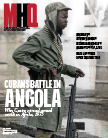
Related stories

Portfolio: Images of War as Landscape
Whether they produced battlefield images of the dead or daguerreotype portraits of common soldiers, […]

Jerrie Mock: Record-Breaking American Female Pilot
In 1964 an Ohio woman took up the challenge that had led to Amelia Earhart’s disappearance.

10 Pivotal Events in the Life of Buffalo Bill
William Frederick Cody (1846-1917) led a signal life, from his youthful exploits with the Pony Express and in service as a U.S. Army scout to his globetrotting days as a showman and international icon Buffalo Bill.

The One and Only ‘Booger’ Was Among History’s Best Rodeo Performers
Texan Sam Privett, the colorfully nicknamed proprietor of Booger Red’s Wild West, backed up his boast he could ride anything on four legs.

Epic Voyage of Vasco da Gama Connected Europe to the East
- Read Later
Vasco da Gama was a Portuguese sailor and explorer who lived between the 15th and 16th centuries. Not only is da Gama a significant figure in the history of Portugal and Europe, but he is also an important personage in world history. Vasco da Gama was the first European to reach India via an oceanic route.
As a result of Vasco da Gama’s voyages , Portugal cemented its reputation as a formidable seafaring nation and grew rich from the goods that were coming from the East. Moreover, da Gama’s discovery of a maritime route connecting Europe to Asia may be regarded to be the beginning of the age of global imperialism.
Not long after da Gama’s first voyage to the East, the Portuguese established their first colony in Asia, when they conquered Goa, in India, in 1510. Portugal’s last colony, Macau, is also in Asia and was only handed back to China in 1999.
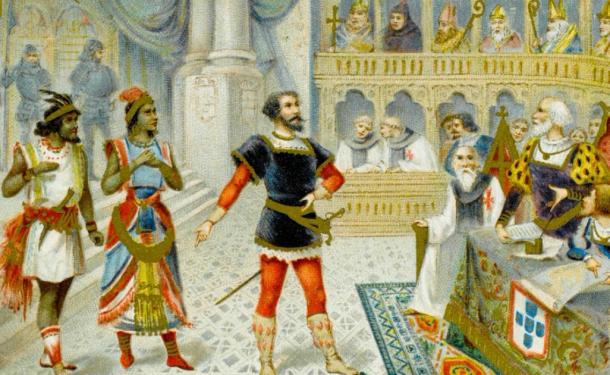
The journey of Vasco da Gama connected Europe and the East. Source: Archivist / Adobe Stock.
The Early Life of Vasco da Gama
Vasco da Gama was born around 1460 in Sines, a coastal town in the Alentejo region, in the southwestern part of Portugal. da Gama’s father was a minor provincial nobleman by the name of Estêvão da Gama, who served as a commander of the town’s castle. Unfortunately, little else is known about da Gama’s early life.
In fact, the next piece of information about Vasco da Gama’s life prior to his voyage to the East comes from 1492. In that year, the King of Portugal, John II, sent da Gama to Setubal, a port city between Lisbon and Sines, to seize French vessels.
This was carried out in retaliation for attacks by the French on Portuguese shipping interests, despite the fact that the two countries were not at war. da Gama proved his capabilities by performing his mission swiftly and effectively.
Politics and the Portuguese Fleet
In 1497, Vasco da Gama was given the task of seeking an oceanic route from Western Europe to the East and was placed at the head of a Portuguese fleet. Although da Gama is one of Portugal’s greatest maritime explorers, he was certainly not its first. In fact, the kingdom began to explore the uncharted waters to its west and south about 80 years before da Gama’s first voyage.
In 1415, the Portuguese crossed the Strait of Gibraltar and captured Ceuta from the Moors. This is considered to be the starting point of the Portuguese Colonial Empire. In the decades that followed, the Portuguese discovered (and colonized) the island of Madeira, and the Azores, and continued their exploration down the western coast of Africa.
Interestingly, one of the reasons that spurred the Portuguese to seek a sea route to the East was the legend of Prester John, who was rumored to be the monarch of a long-lost Christian kingdom in the East. The rulers of Portugal, as Catholics, saw it as their sacred duty to spread Christianity, and to destroy Islam. Therefore, the Portuguese kings were hoping to find this legendary Christian king in the East, form an alliance with him, and encircle the Muslims .
The envisioned ‘grand alliance’ against the Muslims never materialized, since the Portuguese were not able to locate the legendary Prester John. Nevertheless, the Portuguese grew wealthy as a consequence of the commerce that they conducted during their voyages. The most lucrative of all was the African slave trade and the first consignment of slaves was brought to Lisbon in 1441.
Six years after that, Portuguese seafarers had reached as far south as present-day Sierra Leone. The Portuguese arrived in the Congo in 1482 and 4 years later they were at Cape Cross, in present day Namibia. The Portuguese finally reached the ‘southern end’ of the African continent in 1488, when Bartolomeu Dias rounded the Cape of Good Hope.
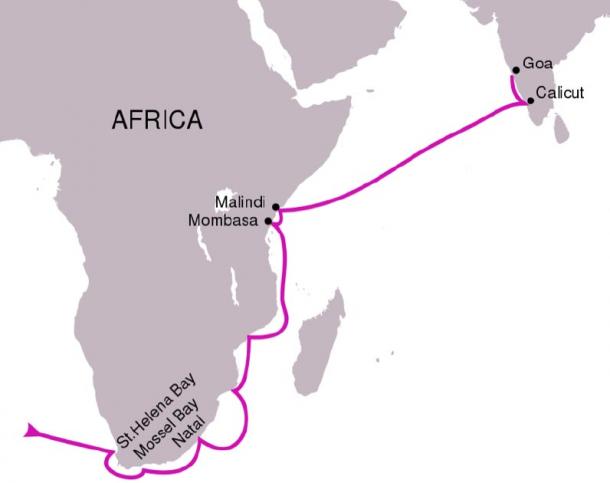
The route followed in Vasco da Gama's first voyage, 1497–1499. (PhiLip / CC BY-SA 4.0 )
It may be pointed out that the Cape of Good Hope was thought (incorrectly) to be the dividing point between the Atlantic and Indian Oceans. Today, however, we know that the southern tip of Africa is in fact Cape Agulhas, located to the southeast of the Cape of Good Hope. While some accounts claim that the name of the landmark was given by Dias himself, others claim that Dias had originally named it ‘Cape of Storms’.
- The Age of Discovery: A New World Dawns
- Ferdinand Magellan: Defying all Odds in a Voyage around the World
- The Lost Treasure of Flor de la Mar, Flower of the Sea
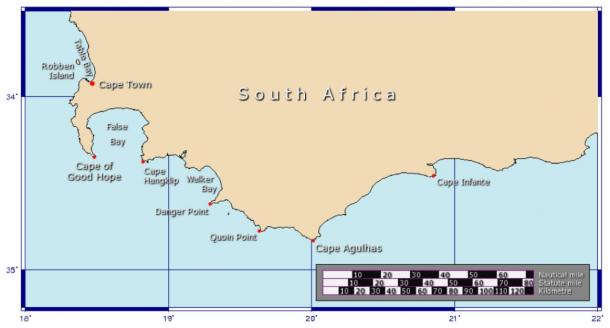
Map of the Cape of Good Hope and Cape Agulhas the southernmost point of Africa. (Johantheghost / CC BY-SA 3.0 )
This was a reference to the stormy weather and rough seas that the area is famous for, which was a challenge for the early seafarers who intended to sail round the cape. The story goes on to say that it was John II who changed the name of the cape from ‘Cape of Storms’ to ‘Cape of Good Hope’, as it was supposed to be a good omen indicating that the Europeans could reach India (and presumably the elusive Prester John as well) via the sea.
It seems that there was a hiatus in Portugal’s exploratory voyages after Dias’ rounding of the Cape of Good Hope, as it took the Portuguese another decade before they finally arrived in India. By that time, John was dead, and had been succeeded by Manuel I, the king who gave Vasco da Gama the mission to seek the maritime route to India.
Manuel has a rather unusual, though appropriate epithet, ‘the Fortunate’. He was the ninth child of Dom Fernando, the younger brother of Afonso V, John’s father and predecessor. Considering his position, it was pretty unlikely that Manuel would ever attain the Portuguese throne. In addition, during John’s reign, Manuel’s only surviving brother was murdered by the king on suspicion of conspiracy.
Manuel, however, was spared, and even made Duke of Beja. In 1491, John’s legitimate son, Afonso, died in a horse-riding accident. For the remaining years of his life, John tried to legitimize his bastard son, Jorge de Lencastre, but without success.
The queen, Eleanor of Viseu, herself opposed John on this matter and supported Manuel as the new heir to the throne. The queen, incidentally, was one of Manuel’s sisters. Thus, in 1494, when John’s health was in decline, he named Manuel as his successor, and when the king died in October the following year, Manuel became Portugal’s new king.
Vasco da Gama’s Mission
It was Manuel who placed Vasco da Gama in charge of the fleet that was to sail to India in 1497. da Gama is said to have lacked the relevant experience to lead such an expedition, though some have suggested that he may have studied navigation prior to this. It is more likely that da Gama was chosen for political reasons – Manuel was in favor of the da Gama family and their supporters.
In any case, Vasco da Gama left Lisbon on the 8th of July 1497. The fleet consisted of four vessels – two medium-sized three-masted sailing ships known as carracks, each weighing about 120 tonnes, a smaller caravel, weighing about 50 tonnes, and a supply ship.
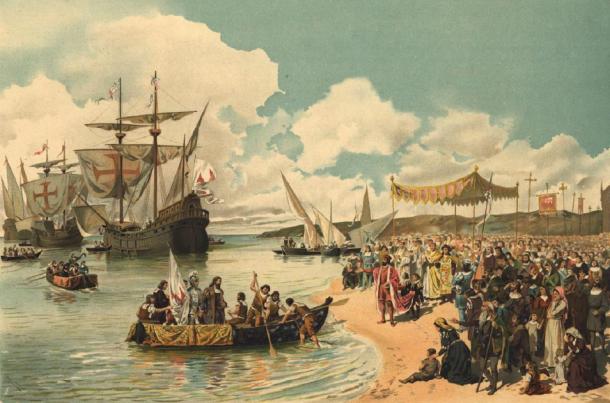
Departure of Vasco da Gama to India in 1497. (Dantadd / Public Domain )
The carracks were named São Gabriel and São Rafael , the former commanded by da Gama himself, while the latter by his brother, Paulo da Gama. The caravel was named São Miguel (nicknamed Berrio ) and commanded by Nicolau Coelho, whereas the name of the supply ship is today unknown and was commanded by Gonçalo Nunes.
The fleet passed the Canary Islands (which was under Spanish control) on the 15th of July and on the 26th arrived at São Tiago in the Cape Verde Islands. The fleet remained on the island until the 3rd of August before continuing their journey. da Gama initially sailed southwards along the west coast of Africa, but then veered far off into the southern Atlantic, in order to avoid the currents in the Gulf of Guinea.
On the 7th of November, the fleet arrived in Santa Helena Bay (in modern South Africa), where unfavorable winds and adverse currents caused da Gama and his men to halt their journey for several weeks. Finally, on the 22nd of November, da Gama rounded the Cape of Good Hope, and continued the journey eastwards.
Three days after rounding the Cape of Good Hope, da Gama set foot on Mossel Bay, and erected a padrão (a stone pillar left by the Portuguese explorers to mark significant landfalls and to establish possession of the area) there. It was also here that the supply ship was scuttled. Around Christmas, da Gama sailed passed a coast that was yet to be explored by Europeans and called it Natal (the Portuguese word for Christmas).
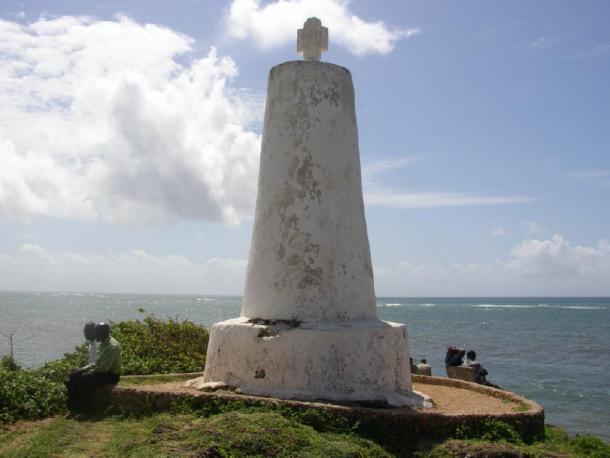
Pillar of Vasco da Gama in Malindi, in modern-day Kenya, erected on the return journey. (Mgiganteus / CC BY-SA 3.0 )
Vasco da Gama’s Journey Continues
In the months that followed, the fleet sailed northwards along the east coast of Africa. In January 1498, the fleet had arrived in the area that is today Mozambique. On the 25th of that month, da Gama and his men reached the Quelimane River, which they called Rio dos Bons Sinais (meaning ‘River of Good Omens’) and set up another padrão . The fleet rested there for a month, as many of the men were suffering from scurvy and the ships needed to be repaired.
On the 2nd of March, da Gama arrived on the island of Mozambique, which was ruled by a Muslim sultan. The islanders believed that the Portuguese were Muslims like themselves and therefore treated them kindly. da Gama gained much information from them and was even given two navigators by the sultan, one of whom deserted when he learned that the Portuguese were in fact Christians.
In April, the fleet reached the coast of modern day Kenya. On the 14th of April, da Gama was in Malindi, where he obtained the service of a Gujarati navigator who knew the way to Calicut, on the southwestern coast of India. On the 20th of May, the fleet arrived in Calicut after sailing for 23 days directly across the Indian Ocean.
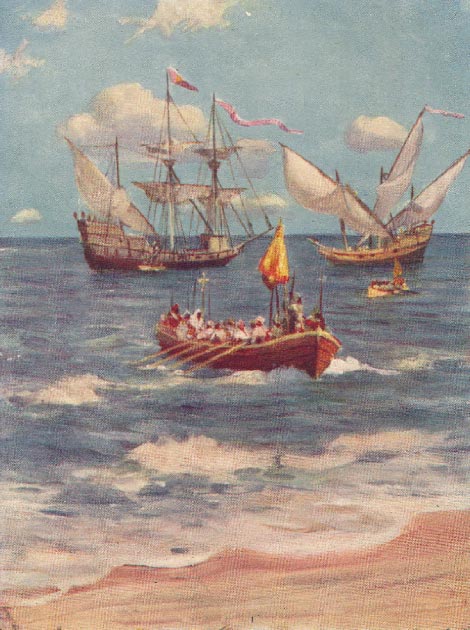
Vasco da Gama landing at Calicut. (Piggy58 / Public Domain )
At Calicut, da Gama’ gifts failed to impress the Zamorin (the Hindu ruler of Calicut). In addition, the Muslims merchants who were already there were hostile towards the Portuguese. As a consequence, the Portuguese failed to conclude a trade treaty with the Indians of Calicut.
- Record Breaking Finds From Portuguese Shipwreck Confirmed by Guinness Book of Records [World’s Oldest Finds]
- Pedro Alvares Cabral: The Lucky Lost Navigator Who Made Brazil Portuguese
- Amerigo Vespucci: The Forgotten Explorer Who Named America
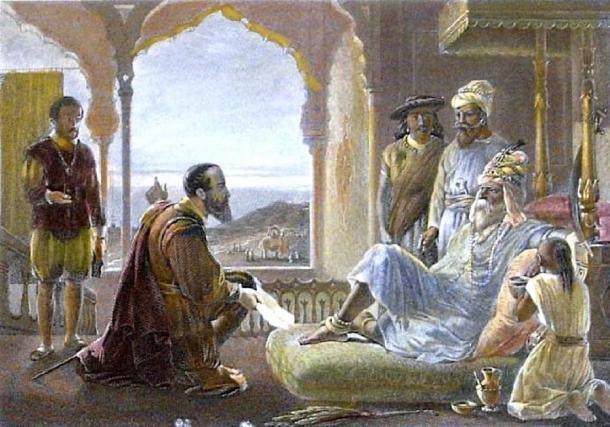
Vasco da Gama meets Zamorin. (Donaldduck100 / Public Domain )
In the meantime, relations between the Portuguese and the Indians grew increasingly tense and Vasco da Gama finally decided to sail back to Portugal at the end of August. The Portuguese, who were still ignorant about the monsoon wind patterns, chose the worst possible time for their return journey. As a result of sailing against the monsoon winds, da Gama took nearly three months to cross the Indian Ocean, during which time many of his crew died of scurvy.
The lack of crew members also forced da Gama to order the destruction of São Rafael when the fleet arrived at Malindi on the 7th of January 1499. The two remaining ships rounded the Cape of Good Hope on the 20th of March but were separated a month later by a storm.
São Miguel arrived in Portugal on the 10th of July, while São Gabriel arrived on the 9th of September. Nine days later, da Gama entered Lisbon, and was welcomed as a hero.
The king bestowed the title Dom on Vasco da Gama, gave him an annual pension of 1000 cruzados, and estates. Nevertheless, da Gama had paid a hefty price for his success – of the original crew of 170 men only 55 returned, and his own brother was among the dead.
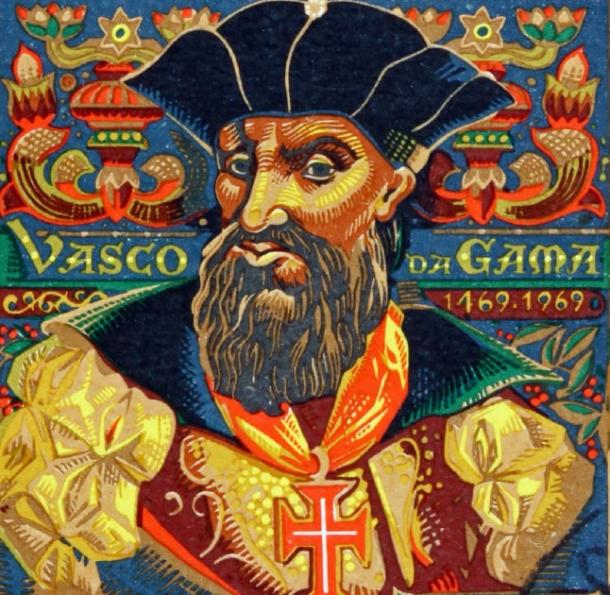
The king granted Vasco da Gama the title of Dom. ( laufer / Adobe Stock)
The Success of Vasco da Gama’s Voyage Demands a Repeat
The success of Vasco da Gama’s voyage encouraged the king to send another fleet, this time consisting of 13 ships, to secure a trade treaty with Calicut. Although relations between the Zamorin and the Portuguese began much better this time round, it quickly went south. The Portuguese came into conflict with the Muslim merchants, who wanted to keep their monopoly on the city’s trade.
As a result, a riot broke out, which overran the Portuguese trading post and many Portuguese were slaughtered. The Zamorin was blamed for the incident and his city was bombarded, thus war was declared by the Portuguese on Calicut.
In 1502, another fleet was set out from Lisbon, under the command of da Gama, who was charged with exacting revenge on Calicut, and to force the Zamorin into submission. Raids were also carried out against Arab merchant ships, and, according to one story, da Gama had captured a pilgrim ship with 200-400 passengers, locked them up in the vessel after plundering its goods, and set fire to the ship.
The story, which may have been false, or at least exaggerated, caused Vasco da Gama to be reviled in that part of the world. Incidentally, one of da Gama’s ships from his second voyage has been found off the coast of Oman and excavated between 2013 and 2015.
Vasco da Gama failed to force the Zamorin to submit and seems to have lost the favor of Manuel when he returned. For the next two decades of his life, da Gama retired to the town of Évora and lived a quiet life with his wife and six sons. He was only sent on his third and last voyage in 1524 by John III, Manuel’s successor.
This time, Vasco da Gama was sent to serve as the Portuguese viceroy in India. In September 1524, da Gama arrived in Goa and began combating the corruption that was plaguing the Portuguese administration in India.
Three months later, however, da Gama died in Cochin as a result of illness, either due to overwork or some other reason. His remains were first buried in St. Francis Church in Cochin, and then brought back to Portugal in 1539 and laid to rest Vidigueira before being transferred to the Jerónimos Monastery in Belém, Lisbon during the late 19th century, where they have remained till today.
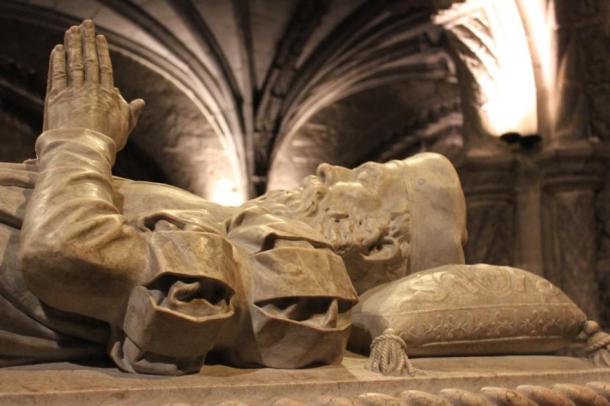
Tomb of Vasco da Gama in the Jerónimos Monastery in Belém, Lisbon. (Christine und Hagen Graf / CC BY-SA 2.0 )
Top image: Portuguese caravel of the 15th century. Vasco da Gama was a Portuguese sailor and explorer. Credit: Michael Rosskothen / Adobe Stock
By Wu Mingren
Updated on January 21, 2021.
Fernandez-Armesto, F., and Campbell, E. 2019. Vasco da Gama . [Online] Available at: https://www.britannica.com/biography/Vasco-da-Gama
History.com Editors. 2018. Vasco da Gama . [Online] Available at: https://www.history.com/topics/exploration/vasco-da-gama
LisbonLisboaPortugal.com. 2020. Vasco Da Gama . [Online] Available at: https://lisbonlisboaportugal.com/Lisbon-information/Vasco_gama.html
Livermore, H. 2019. Manuel I . [Online] Available at: https://www.britannica.com/biography/Manuel-I
New World Encyclopedia. 2019. Portuguese Empire . [Online] Available at: https://www.newworldencyclopedia.org/entry/Portuguese_Empire
Romey, K. 2016. Shipwreck Discovered from Explorer Vasco da Gama's Fleet . [Online] Available at: https://www.nationalgeographic.com/news/2016/03/20160314-oman-shipwreck-explorer-vasco-da-gama-age-of-exploration-india-route/
Szalay, J. 2016. Vasco da Gama: Facts & Biography . [Online] Available at: https://www.livescience.com/39078-vasco-da-gama.html
The BBC. 2014. Vasco da Gama (c.1460 - 1524) . [Online] Available at: http://www.bbc.co.uk/history/historic_figures/da_gama_vasco.shtml
The Editors of Encyclopaedia Britannica. 2019. Cape of Good Hope . [Online] Available at: https://www.britannica.com/place/Cape-of-Good-Hope
The Mariners' Museum & Park. 2020. Vasco da Gama . [Online] Available at: https://exploration.marinersmuseum.org/subject/vasco-da-gama/

Wu Mingren (‘Dhwty’) has a Bachelor of Arts in Ancient History and Archaeology. Although his primary interest is in the ancient civilizations of the Near East, he is also interested in other geographical regions, as well as other time periods.... Read More
Related Articles on Ancient-Origins
- Vasco da Gama

Famous explorer Vasco da Gama was born in Sines, Portugal around 1460. The King commissioned him in 1497 to find a maritime-route to the East of the country. His breakthrough proved to be among the most instrumental highlights in navigation history.
Explorer Vasco da Gama was born into a noble and humble family. He was the third son of his father Estevao da Gama, a fortress commander in his hometown. He was known to be a fearless and tough young man.
Contribution to Navigation
Once he was older, Vasco da Gama joined the Portuguese navy where he learned to navigate. He established himself as a sailor by 1492 when King John II dispatched him to south Lisbon. He was then again dispatched to the Algarve region of Portugal to seize ships from France. This was done as a sign of revenge against the French for disrupting their shipping before.
The idea of exploring the farther parts of the world were not a new concept to da Gama since his father was also an explorer.
First Voyage
He started on his first voyage in 1487 from Lisbon, Portugal to India. The main reason India was a popular merchant route was because of its spices. Vasco da Gama used the naval route south of Africa, passing through Mombasa and the Cape of Good Hope.
He finally reached Southern India in 1498. He then returned back after successful trade exchanges in 1499. This navigation led to a direct route from the European continent to India.
Second Voyage
The Portuguese King Manuel I sent da Gama, then an admiral, on a second expedition to India between 1502 and 1503. On his second trip, Vasco da Gama took with him 20 armed ships. Vasco da Gama was the main force in subduing lots of uprisings, mostly with the Muslim traders, who carried out their trade in Africa.
This second voyage saw the killing of several Muslims, who were often murdered brutally as a way of demonstrating the King’s power. The Muslims traders felt that the Portuguese had jeopardized their route because of the many entries of European ships into their waters. This was the main cause of the conflicts.
In 1524, da Gama was asked to undertake yet another voyage to India, this time, as a viceroy and ambassador of King John III. However, this journey proved to be very unfortunate as da Gama died from malaria. His remains were sent back to his homeland in 1539.
Famous Explorers
- Amerigo Vespucci
- Bartolomeu Dias
- Captain James Cook
- Christopher Columbus
- Daniel Boone
- Edmund Hillary
- Ferdinand Magellan
- Francisco Pizarro
- Francis Drake
- Hernando de Soto
- Hernán Cortés
- Henry Hudson
- Ibn Battuta
- Jacques Cartier
- Jacques Cousteau
- Juan Ponce de León
- Leif Ericson
- Lewis and Clark
- Neil Armstrong
- Reinhold Messner
- Roald Amundsen
- Samuel de Champlain
- Yuri Gagarin
Copyright © 2018 · Famous Explorers · All Rights Reserved. | Disclaimer | Privacy Policy
Have Fun With History
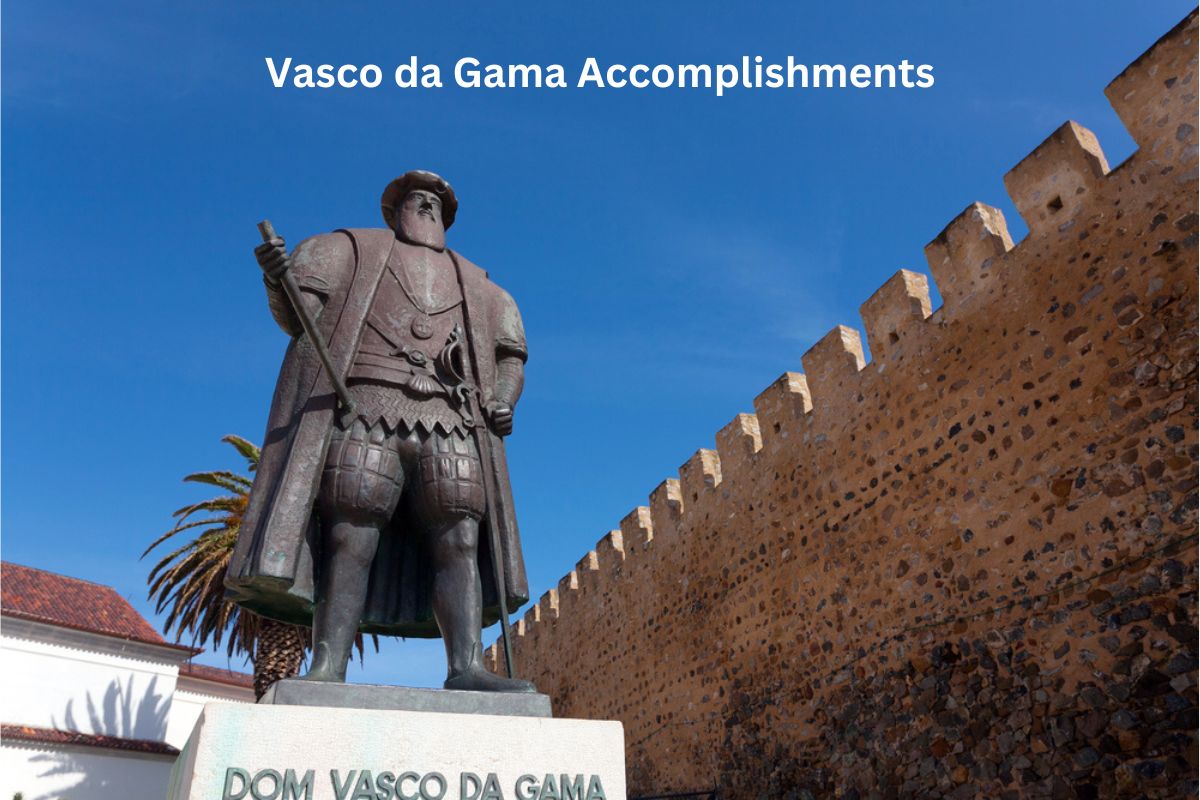
10 Vasco da Gama Accomplishments and Achievements
Vasco da Gama, a Portuguese explorer of the late 15th and early 16th centuries, achieved a series of remarkable feats that left an enduring mark on history.
His expeditions and accomplishments reshaped global trade routes, expanded maritime exploration, and established Portugal as a dominant player in the Age of Exploration.
From his groundbreaking discovery of a sea route to India to his pivotal role as a diplomat and navigator, da Gama’s legacy as a symbol of exploration continues to inspire and captivate generations.
Accomplishments of Vasco da Gama
1. discovered a sea route to india.
One of Vasco da Gama’s most remarkable achievements was finding a direct sea route from Europe to India.
Prior to his expedition, trade between Europe and the lucrative markets of Asia, particularly India, was primarily conducted through overland routes, involving numerous intermediaries that increased costs.
Also Read: Facts About Vasco da Gama
Da Gama’s successful navigation around the southern tip of Africa, the Cape of Good Hope, allowed European ships to bypass these traditional routes, significantly reducing travel time and costs.
2. Led the first successful voyage to India in 1498
In 1498, Vasco da Gama embarked on a daring journey with a fleet of four ships, aiming to reach India.
After months of navigating uncharted waters, facing harsh conditions, and overcoming navigational challenges, da Gama’s expedition reached the port of Calicut on the southwestern coast of India.
Also Read: Timeline of Vasco da Gama
This historic achievement marked the first direct sea connection between Europe and India, a monumental event that reshaped global trade and established Portugal’s reputation as a pioneering maritime power.
3. Established Portugal’s maritime dominance
Vasco da Gama’s successful voyage to India had profound geopolitical and economic implications.
By securing a direct sea route to the Indian Ocean, Portugal gained a competitive advantage in the lucrative spice trade, which was previously controlled by Arab and Venetian intermediaries.
This accomplishment enhanced Portugal’s influence in the Indian Ocean region, allowed for the establishment of trading posts and colonies along the way, and laid the foundation for Portugal’s subsequent maritime and colonial dominance during the Age of Exploration.
The success of da Gama’s voyage bolstered Portugal’s reputation as a seafaring nation and encouraged other European powers to explore new routes and territories.
4. Negotiated trade agreements along the route
During his voyages, Vasco da Gama not only explored new territories but also engaged in diplomacy and trade negotiations. He understood the importance of establishing friendly relations with local rulers and merchants to ensure the success of Portugal’s trading ventures.
Da Gama negotiated trade agreements and secured trading privileges with various rulers along his route, particularly in East African ports such as Mozambique and Malindi.
These agreements allowed Portugal to establish trading posts and gain access to valuable commodities like spices, textiles, and precious metals.
5. Documented the journey’s details
Accompanying Vasco da Gama on his pioneering voyages was Álvaro Velho, a chronicler who meticulously recorded the details of the journey.
Velho’s writings, known as the “Roteiro” or “Book of Routes,” provide invaluable insights into the geographic features, cultures, encounters, and challenges faced during the expeditions.
This documentation not only served as a navigational guide for future explorers but also offered a rich source of information about the lands and peoples encountered during da Gama’s journeys.
6. Pioneered the Cape route around Africa
One of da Gama’s significant contributions to navigation was proving that ships could successfully navigate the treacherous waters around the southern tip of Africa, known as the Cape of Good Hope.
Prior to his expedition, there was uncertainty and fear about the dangers posed by this route, including unpredictable weather conditions and uncharted waters.
Da Gama’s successful passage through this challenging route demonstrated that it was a viable path to reach the Indian Ocean. This achievement opened up new possibilities for maritime trade and exploration, as it provided a safer alternative to the overland routes that required traversing vast and often hostile territories.
7. Initiated trade with East African ports
Along his journey to India, Vasco da Gama established important trade relations with various East African ports. Notably, he secured alliances and trade agreements with ports like Mozambique and Malindi.
These interactions were crucial for obtaining supplies, such as fresh water, food, and repairs, as well as for gathering information about navigational routes, local cultures, and trading opportunities.
By fostering these relationships, da Gama paved the way for future Portuguese expeditions and trade networks along the East African coast.
8. Undertook subsequent successful voyages to India
Building on the success of his first voyage, Vasco da Gama embarked on two subsequent expeditions to India.
These voyages further solidified Portugal’s presence in the Indian Ocean and allowed da Gama to establish and expand trading posts, as well as negotiate additional trade agreements with local rulers.
His leadership and navigation skills continued to play a crucial role in enhancing Portugal’s influence in the region.

9. Served as both navigator and diplomat
Vasco da Gama’s accomplishments extended beyond navigation; he also excelled as a diplomat. His ability to navigate uncharted waters was complemented by his skill in negotiating with diverse cultures and rulers.
Da Gama’s diplomatic efforts were essential for establishing trade relationships, securing safe harbors, and maintaining peaceful interactions with local communities. His dual role as both a navigator and a diplomat contributed to the success of Portugal’s maritime endeavors.
10. Left a lasting legacy as a symbol of exploration
Vasco da Gama’s legacy as an explorer and pioneer endured long after his lifetime. His achievements symbolized the spirit of exploration and the daring quest for new horizons during the Age of Exploration.
Da Gama’s accomplishments inspired generations of explorers, navigators, and adventurers who followed in his footsteps. His name became synonymous with the discovery of new trade routes and the expansion of geographical knowledge, leaving an indelible mark on history and shaping the course of global exploration and colonization.
Vasco da Gama’s contributions encompassed not only navigation and exploration but also diplomacy, trade, and inspiration. His legacy is intertwined with the opening of maritime trade routes, the establishment of colonial outposts, and the broader historical narrative of European exploration and expansion during the Renaissance era.

- Virginia Beach
- History & facts
- Famous people
- Famous landmarks
- AI interviews
- Science & Nature
- Tech & Business
Discover something new everyday
- Famous places
- Food & Drinks
- Tech & Business
Lisbon - Portuguese culture , Lisbon - Top 10
15 interesting facts about Vasco Da Gama
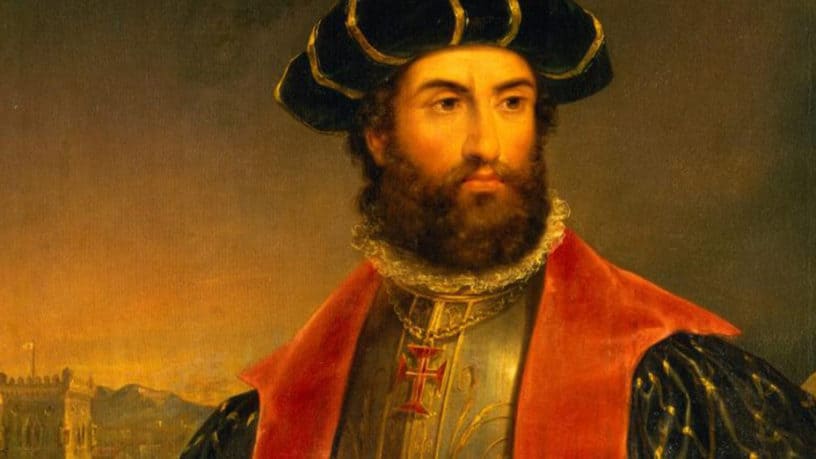
Read Next →

Lisbon - Top 10
Top 10 best wedding venues in Lisbon

Lisbon - Portuguese culture
Fashion Trends in Portugal

Top 6 inventions by the Portuguese
Who was vasco de gama his early life and youth, what did vasco de gama discovered.
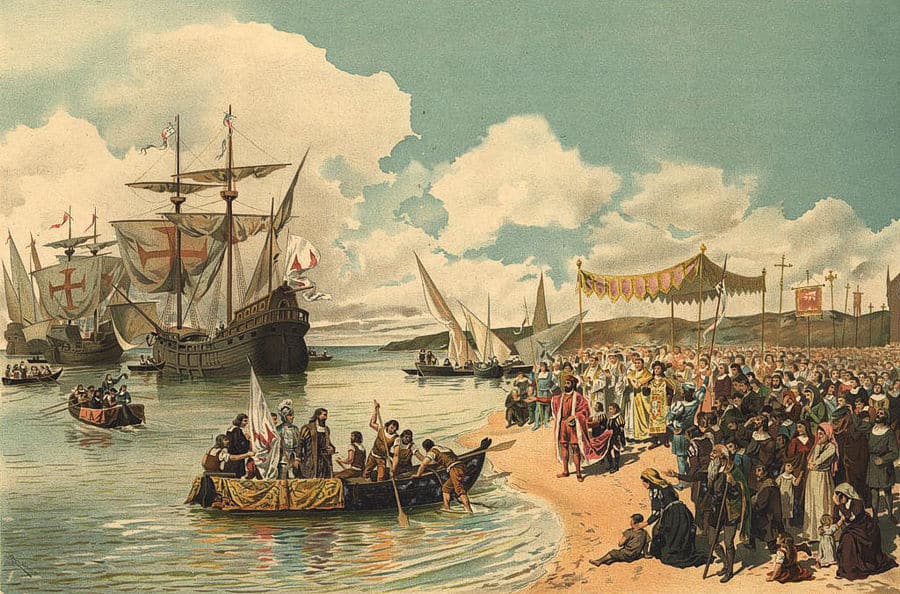
He was sent by the King to explore the west
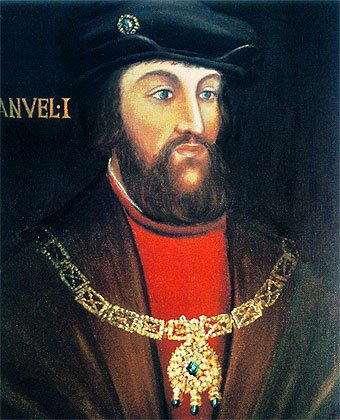
About his crew
Vasco da gama was known to be brutal.
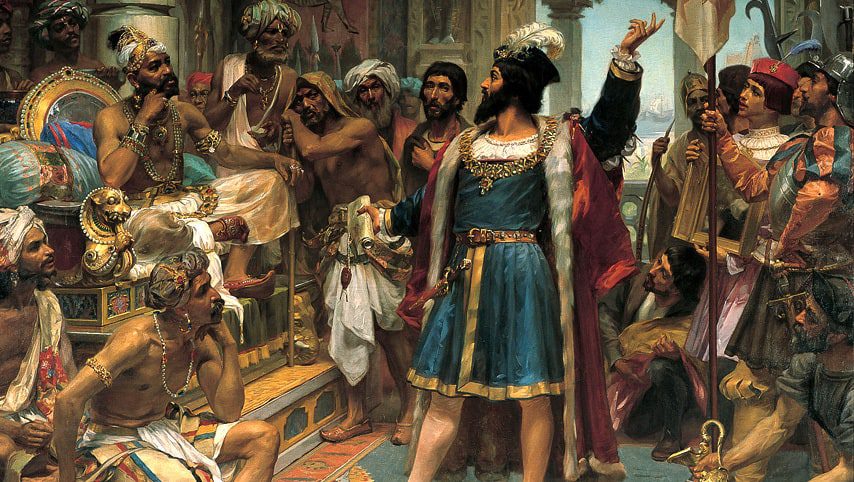
He was a hero for the Portuguese
Vasco da gama greatly contributed to the wealth of portugal.
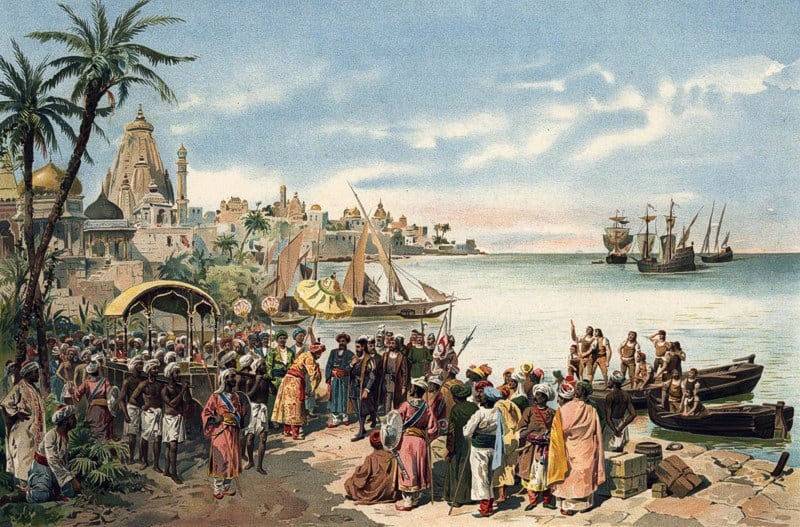
Portugal economy was on the rise thanks to him
His explorations affected the religious world, the europeans got to discover plenty of new goods.
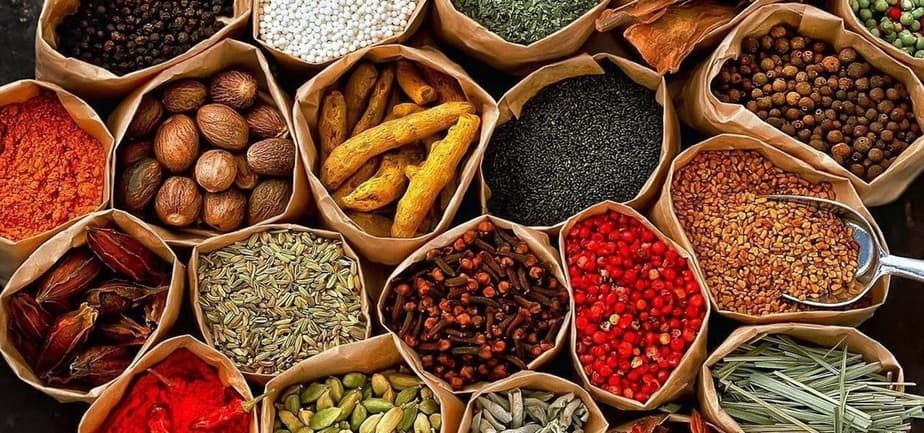
Vasco Da Gama had six kids
Da gama looted a ship , vasco da gama was a knight’s son, vasco da gama received numerous honours in portugal, he first noted evidence of trading in malindi, so how did vasco de gama die, an additional curious fact, 3 of vasco da gama’s most famous voyages, 1. first voyage to india (1497-1499).
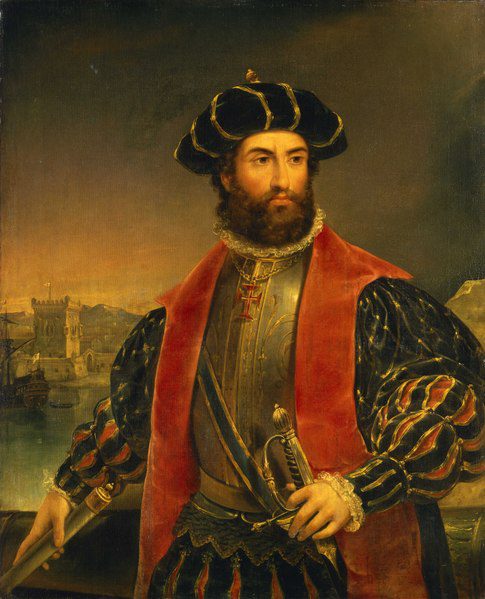
António Manuel da Fonseca , Public domain, via Wikimedia Commons
2. Second Voyage to India (1502-1503)
3. voyage to mozambique and east africa (1498-1499).
Planning a trip to Paris ? Get ready !
These are Amazon’s best-selling travel products that you may need for coming to Paris.
- The best travel book : Rick Steves – Paris 2023 – Learn more here
- Fodor’s Paris 2024 – Learn more here
Travel Gear
- Venture Pal Lightweight Backpack – Learn more here
- Samsonite Winfield 2 28″ Luggage – Learn more here
- Swig Savvy’s Stainless Steel Insulated Water Bottle – Learn more here
Check Amazon’s best-seller list for the most popular travel accessories. We sometimes read this list just to find out what new travel products people are buying.
Anna was born and raised in Paris. She studied Languages in Paris and Social Communication in Lisbon. Anna also lived in Madrid for a year. She has been to many places and hopes to go places. Wherever she goes, she always tries to experience each city as locals do. Anna usually has croissants for breakfast in Paris, takes a walk in Camden Town in London, eats lunch in Chiado in Lisbon, and enjoys Madrid's nightlife.
Hello & Welcome
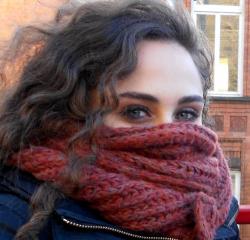
Popular Articles

Top 20 Streets to See in Paris

Paris in two days

Top 15 Things to do Around the Eiffel Tower

The Best Way to Visit Paris Museums

Top 15 Fashion Stores in Le Marais
Visit europe with discover walks.
- Paris walking tours
- Montmartre walking tour
- Lisbon walking tours
- Prague walking tours
- Barcelona walking tours
- Private tours in Europe
- Privacy policy
© 2024 Charing Cross Corporation
- Skip to primary navigation
- Skip to main content
- Skip to primary sidebar

- Native Americans
- Age of Exploration
- Revolutionary War
- Mexican-American War
- War of 1812
- World War 1
- World War 2
- Family Trees
- Explorers and Pirates
Vasco da Gama Biography, Facts, Timeline
Published: Sep 22, 2011 · Modified: Nov 12, 2023 by Russell Yost · This post may contain affiliate links ·
Historians disagree on the date of Vasco da Gama's birth. It was either 1460 or 1469 in Sines on the southwest coast of Portugal. His father was Estevao da Gama, who was also famous in his time.
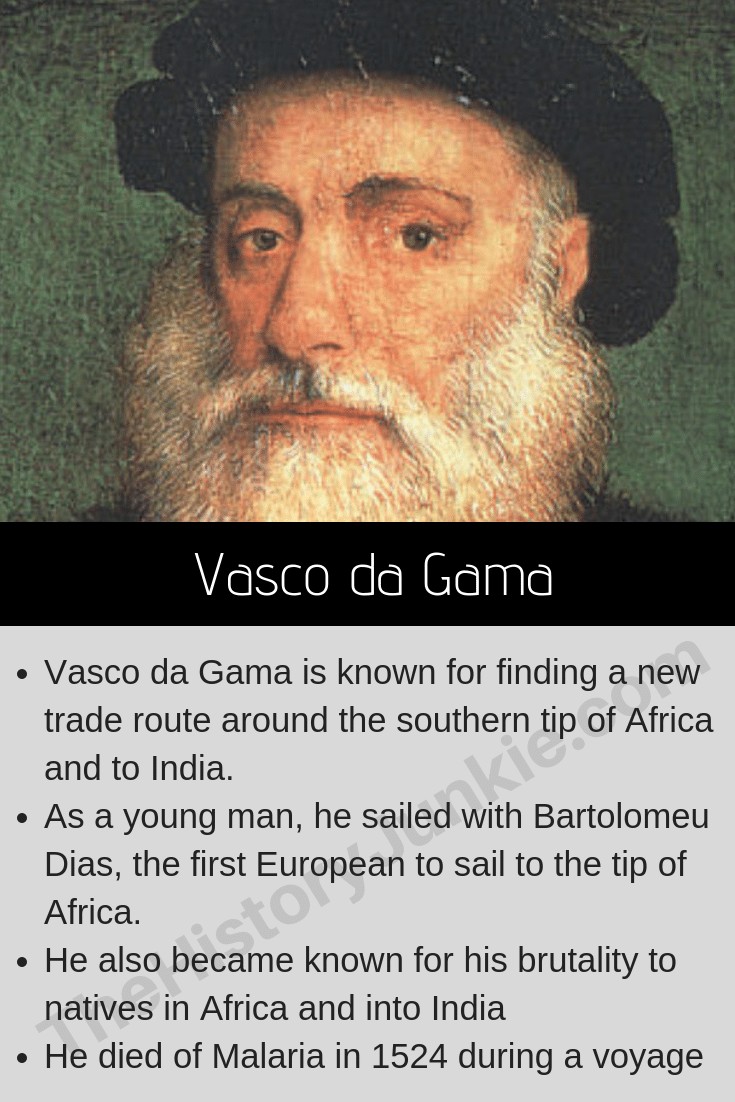
In 1460, he was appointed as a knight of the household of Infante Ferdinand, Duke of Viseu. He would hold this position until around 1478.
His father married Isabel Sodre. Sodre had connections with the household of Infante Ferdinand, which led to a profitable marriage.
Vasco da Gama was the third of five brothers. He also had a sister. This is all that is known of his childhood and adolescent years.
In 1480, he joined the Order of Santiago, whose master was Prince John. John would eventually ascend to the Portuguese throne and become King John II.
This connection would serve him well. Twelve years later, King John would send Vasco da Gama on a mission to seize French ships. Vasco did so, and he did it with much speed and effectiveness.
The Explorer
He would get his first taste of exploration with Bartolomeu Dias when he has sailed around what is now called the Cape of Good Hope.
Dias would not reach India. His mission was to prove that it was possible to sail around the Cape of Good Hope.
On July 8th, 1497, Vasco da Gama set out on his first voyage with 170 men from Lisbon. His mission would be to sail around the Cape and make his way to India.
On December 16th, 1497, Vasco da Gama reached the point where Bartolomeu Dias turned back. Vasco da Gama continued with the hope that he would find a new route to India.
During his voyage, he realized that the Eastern African coast was primarily Muslim. He believed that it would hinder him if they found out that he was Christian.
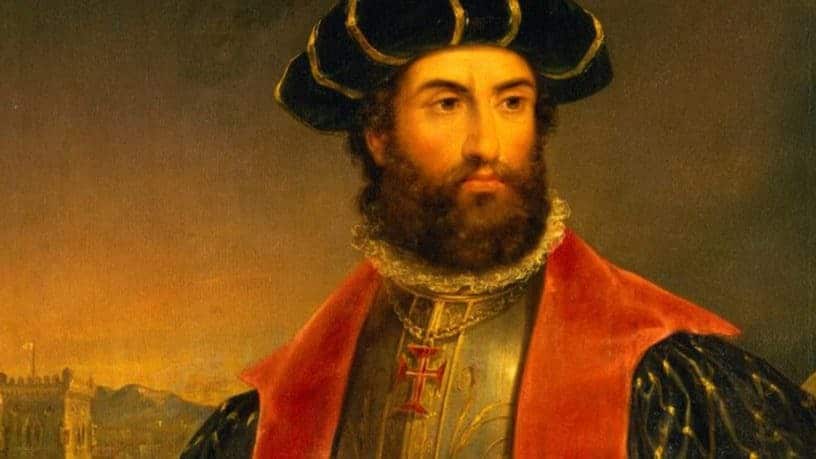
In order to gain an audience with the Sultan of Mozambique, he acted as if he was a Muslim. Unfortunately, he was unable to give a suitable gift to the Sultan and was met with hostility and left.
While leaving, he turned his ship and fired into the city.
Around the city of Mombasa, da Gama began looting Arab merchant ships that were unarmed. This would not go over well with the Mombasa population. Although da Gama was the first European to sail into the port of Mombasa, he was met with hostility.
In February of 1498, about 8 months after he first left Lisbon, he sailed into the port of Malindi. Malindi was friendly and happened to be at war with Mombasa. This is where da Gama first learned of Indian trade vessels. From here, he would set sail to Calicut, India.
Vasco da Gama arrived near Calicut on May 20th, 1498. The Kind of Calicut was hospitable but unimpressed with da Gama's gifts. Muslim traders who perceived the Europeans as a rival accused him of being nothing more than a pirate.
These things would strain the relationship between the King and Vasco da Gama. Even so, he would return to Portugal with riches worth 60 times more than the expedition.
Vasco da Gama returned to Portugal in September of 1499. Upon his return, he would receive the title "The Admiral of the Indian Seas."
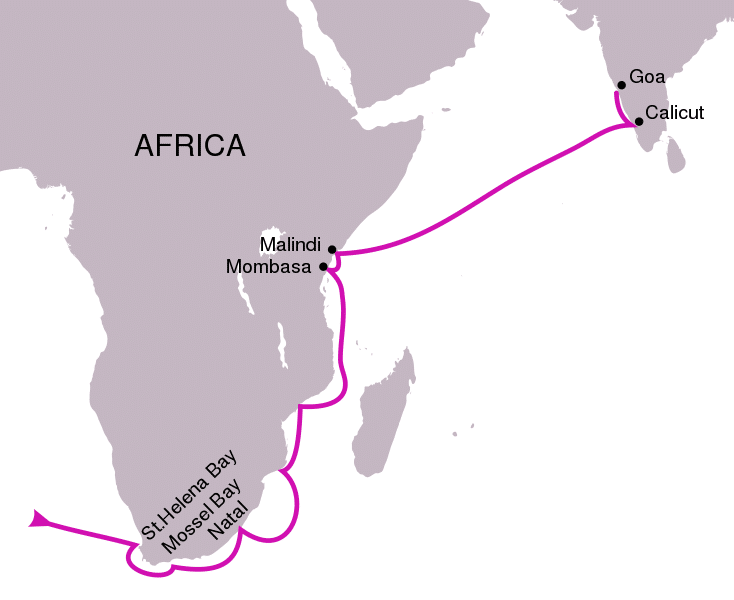
Other Voyages and Cruelty
Vasco da Gama and the 4th Portuguese Armada would set sail for Calicut a second time on February 12th, 1502. This voyage would be different, and he would inflict many acts of cruelty along the way.
Upon his second arrival in India, Vasco da Gama began to seize any Arab vessel he came across.
This led to the notorious Pilgrim Ship incident in which he captured a vessel carrying Muslims on a pilgrimage from Calicut to Mecca. Gasper Correia, a Portuguese historian, described his acts as one that is unequaled in cold-blooded cruelty.
The Portuguese explorer looted the ship that was carrying 400 pilgrims. Among them were 50 women. He then proceeded to lock in every passenger onboard and raze the ship. Women were bringing up their wealth and babies and begging for mercy.
It is said that they brought up enough gold to ransom all the Christians in the Kingdom of Fez. Vasco da Gama would not spare any and burned alive every man, woman, and child.
During his visit to Calicut, he demanded that the King expel every Muslim from India. The King would refuse.
In retaliation, Vasco da Gama would bombard the city, destroying many houses, and would also seize a rice vessel, capture the crew, and cut off their hands, nose, and ears.
The King sent a priest to speak to Vasco da Gama. Da Gama would call him a spy and cut off his lips and ears, and then proceed to sew a pair of dog ears onto his head.
After his privateer actions, he would return to Portugal with numerous riches.
Later Life and Death
In 1519, da Gama would become the first Portuguese Count who was not born of royal blood.
In 1524, he embarked on his final journey. He was asked to replace the Viceroy Eduardo de Menezes. Along the journey, he contracted Malaria and would die in the city of Cochin on Christmas Eve .
His body would be buried in the city of Kochi. His remains were sent back to Portugal 15 years later in 1539.
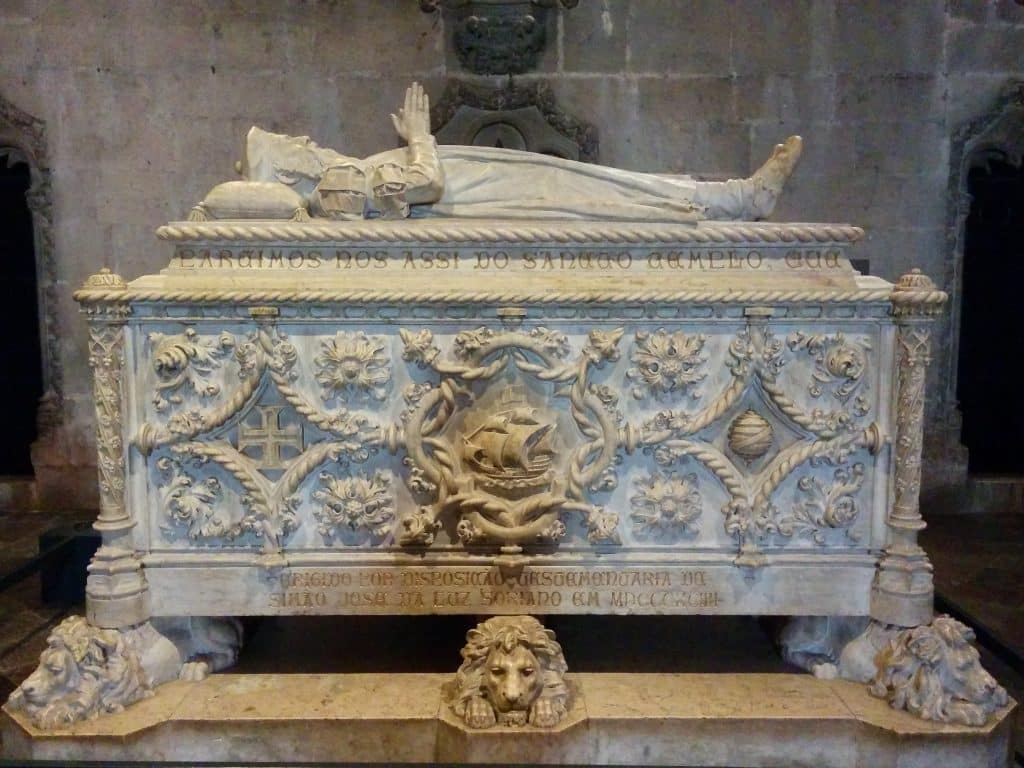
Life and Voyages of Vasco da Gama Explained
Early Life and Background
Vasco da Gama was born in 1469 in Sines, a small port town in the Alentejo region of Portugal. He was the third son of Estêvão da Gama, a nobleman, and Isabel Sodré, a daughter of a wealthy merchant family. From an early age, Vasco was exposed to the maritime life and sailing, as his father was a navigator in the service of the Portuguese royal family.
The First Voyage
In 1497, King Manuel I of Portugal assigned Vasco da Gama the task of finding a sea route to India. The Portuguese had long been trading with India, but the land routes were treacherous and expensive. The Portuguese wanted to find a direct sea route to India to avoid the middlemen and monopolize the spice trade.
Vasco da Gama set sail from Lisbon with four ships, and after a long and arduous journey, he reached Calicut, India, in 1498. The voyage was marked by several challenges, including storms, disease, and hostile encounters with Arab traders. However, Vasco da Gama persevered and managed to establish trade relations with the local rulers.
The Second Voyage
In 1502, Vasco da Gama returned to India with a fleet of 20 ships, which included four warships. The Portuguese were determined to establish their dominance in the Indian Ocean and to control the spice trade. Vasco da Gama attacked several Arab ports and destroyed the Arab fleet. He also established Portuguese colonies in India, including Goa and Diu.
Challenges Faced by Vasco da Gama:
Vasco da Gama’s voyages were not without challenges. Some of the major obstacles he faced are:
- Navigation Challenges: Vasco da Gama had to navigate uncharted territories with limited resources. He relied on his skills and experience to sail through unfamiliar waters.
- Disease and Starvation: Disease and starvation were constant threats during long voyages. Vasco da Gama’s crew had to face these challenges and overcome them to reach their destination.
- Hostile Encounters: Vasco da Gama faced hostile encounters with other ships and indigenous people during his voyages. He had to be prepared to defend his crew and ship at all times.
- Language Barriers: Communication was a significant challenge for Vasco da Gama. He had to rely on interpreters and non-verbal communication to interact with the locals.
Impact of Vasco da Gama’s Voyages on Indigenous People of India:
Vasco da Gama’s voyages had a profound impact on the indigenous people of India. The consequences of European colonialism are still felt today. Here are some of the major impacts of Vasco da Gama’s voyages on the indigenous people of India:
- Economic Impact: Vasco da Gama’s expeditions opened up new trade routes that connected India with Europe. This led to the exploitation of India’s resources, which caused economic hardships for the locals.
- Cultural Impact: The arrival of Europeans in India had a significant impact on the local culture. The Europeans introduced new religions, languages, and customs that changed the cultural landscape of India.
- Political Impact: Vasco da Gama’s voyages marked the beginning of European colonialism in India. The Portuguese, Dutch, and British followed in his footsteps, and their colonial rule lasted for centuries.
- Social Impact: The arrival of Europeans in India had a significant impact on the social structure of the country. The caste system, which was already prevalent in India, was further reinforced by the Europeans.
Consequences of European Colonialism:
The consequences of European colonialism in India are still felt today. Here are some of the major consequences:
- Economic Exploitation: European colonialism led to the exploitation of India’s resources, which caused economic hardships for the locals.
- Cultural Domination: The Europeans introduced their language, religion, and customs, which led to the erasure of indigenous cultures.
- Political Control: The Europeans gained political control over India, which lasted for centuries.
- Social Inequality: The caste system was further reinforced by European colonialism , leading to social inequality and discrimination.
Later Life and Legacy
Vasco da Gama returned to Portugal in 1503 and was received as a hero. He was awarded the title of “Admiral of the Indian Seas” and given a substantial pension. Vasco da Gama made one more voyage to India in 1524 but fell ill and died in Cochin, India, on December 24, 1524.
Vasco da Gama’s voyages opened up a new era of European expansion and colonialism. The Portuguese established a vast empire in Asia and Africa, which lasted for over 500 years. Vasco da Gama is also credited with introducing Christianity to India and helping to spread Portuguese culture and language.
In conclusion, Vasco da Gama was a pioneering explorer who helped to shape the course of world history. His voyages to India opened up new trade routes, established new colonies, and laid the foundations for European colonialism. Vasco da Gama’s legacy lives on, and his achievements continue to inspire new generations of explorers and adventurers.
Q. Who was Vasco da Gama? A. Vasco da Gama was a Portuguese explorer who undertook voyages to find a sea route to India.
Q. What were the major challenges faced by Vasco da Gama during his voyages ? A. Navigation challenges, disease and starvation, hostile
Are you struggling with your paper? Let us handle it - WE ARE EXPERTS!
Get started
Starts at $9 /page
Recent Customer Feedback
See more customer feedback.., how our paper writing service works.
It's very simple!
Complete the order form by providing as much information as possible, and then click the submit button.
Select your preferred writer for the project, or let us assign the best writer for you.
Allocate funds to your wallet. You can release these funds to the writer incrementally, after each section is completed and meets your expected quality.
Download the finished work. Review the paper and request free edits if needed. Optionally, rate the writer and leave a review.

The incredible voyage of Vasco da Gama to India

The Portuguese explorer, Vasco da Gama, is famous for being the first European to sail from Europe to India. Every European naval power was seeking a trade route to the east over the ocean during the 15th century.
Building upon the efforts of previous explorers who had traveled down the west coast of Africa, da Gama was the one that finally made it a reality.
Vasco da Gama was born at the town of Sines in Portugal at some time before 1470.
Both of his parents were from the Portuguese nobility, and his father was involved in the royal court.
da Gama went to school in Evora village, where he developed a love of navigation and sailing.
By the time he had turned 20 years old, he had become a sea captain.
As da Gama was growing up, Portugal was in the middle of an exploration boom. European nations were looking for a sea route to the east.
Traditionally, any trade between Europe and Asia had to travel over land and through the Muslim nations in the Middle East.
These nations would charge high taxes for anyone travelling through their lands.
Therefore, the kings and queens of the various European kingdoms thought that a sea route to the east, travelling around the south of Africa, would be quicker and cheaper.
To that end, Prince Henry the Navigator of Portugal, paid for a number of explorers to sail down the west coast of Africa in search of a safe route.
Then, from 1481, King John II of Portugal did the same. One of these explorers, called Bartolomeu Dias , finally made it to the Indian Ocean in 1488, but did not reach India.
In 1495, a new king ruled in Portugal.
He was called Manuel and he decided to send another fleet to try and reach India .
He chose Vasco da Gama for the task.

da Gama's voyages
da Gama sailed from Lisbon on the 8th of July 1497. By November 22, da Gama reached Mossel Bay in South Africa.
In March he reached Mozambique on the east coast of Africa: the furthest any Portuguese sailor had yet reached.
While there, da Gama spoke to local Muslim merchants to gain information about crossing the Indian Ocean.
After paying for the services of an experienced navigator to join his crew, da Gama set sail for India.
After a journey on the open ocean for 23 days, he finally reached India on the 20th of May 1498.
At the Indian city of Calicut, da Gama had a meeting with the king, but was treated with suspicion.
da Gama spent a few months in India, trading goods and studying India culture. In August 1498, da Gama set off home again, and arrived back in Portugal in September 1499.
King Manuel I was thrilled that da Gama had achieved a round-trip from India, and promoted him to the position of admiral.
Deteriorating reputation
Vasco da Gama sailed back to India in February 1502 with a much larger fleet. On the way, he stopped at Tanzania in Africa, where tensions with the locals led to da Gama threatening them to become servants of the Portuguese king.
This event was the first sign of da Gama's willingness to use force to achieve his aims.
When da Gama arrived back at Calicut in India, he fired his ships cannons at the city's port, killing a number of Muslim traders.
Sailing on to Cochin, they successfully fought a naval engagement against Arab ships.
By this stage, da Gama had gained a reputation as a competent, yet ruthless, captain.
After conducting a trade mission, da Gama sailed back to Portugal in February 1503, arriving back in October.
da Gama did not sail to India again until King Manuel I died in 1521. The new king, John III, promoted da Gama to be the Portuguese viceroy of India to deal with mass corruption among officials that had developed since Portuguese traders had flooded into the country.
da Gama arrived in India, at Goa, in September 1524 and immediately enforced laws to control corrupt Portuguese merchants.
However, he soon fell ill and died on December 24, 1524 in Cochin.
What do you need help with?
Download ready-to-use digital learning resources.

Copyright © History Skills 2014-2024.
Contact via email
- Corrections
4 Famous Explorers from the Age of Exploration
From the 15th to the 17th century, European seafarers explored the world, reaching new distances and lands well beyond their knowledge. It was the Age of Exploration.

The Age of Exploration is a major chapter of world history and a defining moment of the Early Modern Era. From around the 15th century, though one could argue earlier, European explorers undertook a transformative task: the extensive overseas exploration of the world. Coinciding with the Age of Sail in maritime history, European explorers took sailing ships and reached faraway lands, meeting new worlds and starting a dramatic transformation. The Age of Exploration marked an evolution of navigation, global trade, and warfare. It also marked a darker chapter: the first wave of European colonization. Here are four of the famous explorers who pioneered this era.
1. Christopher Columbus & His Voyages to the Americas

Perhaps the most famous European explorer in history, Christopher Columbus was responsible for the so-called Discovery of the Americas when he and his crew set foot in the Bahamas and met with Indigenous Americans in 1492. Columbus was actually not the first to discover the Americas, nor was he the first European to set foot on the continent. But his expeditions remain a significant chapter in history and were highly consequential.
Columbus’ voyages to the Americas began in 1492 after he convinced the Spanish Crown to sponsor his expedition. He completed four voyages in total, the first being his most famous. His fourth voyage sought to make him the first man to circumnavigate the world but was ultimately unsuccessful. Much like other explorers, Columbus was a navigator, a seafarer, and a trader.
But Columbus was also a ruler, not separate from the politics of his time. At one time, he was even arrested in the name of the Spanish Crown, being sent back to Spain after an expedition was sent to investigate his cruel rule in the West Indies. The Spanish Crown eventually sided again with Columbus and sponsored his fourth voyage.
Get the latest articles delivered to your inbox
Please check your inbox to activate your subscription.
Cristopher Columbus’ legacy is largely controversial. Considered by some a discoverer and by others a conqueror, he remains an important figure whose actions changed the world as we know it. By winning over the Spanish Crown , Columbus, a Genoese, set the first stone of globalization.
2. Vasco da Gama & His Voyages to India and Africa

Vasco da Gama was a renowned Portuguese explorer whose greatest achievement was commanding the first ships that traveled directly from Europe to India. Da Gama came from a privileged background: his father was a knight and was appointed civil governor of their hometown. He received taxes from said appointment and was also governor of the Military Order of Christ. Although much about Da Gama’s early life is generally unknown, historians believe that Da Gama received a good education, being instructed in mathematics and navigation.
Portuguese King John II assigned Da Gama to chastise the French navy in the South of Portugal for their acts of vandalism committed against Portuguese navigation efforts. Da Gama was successful in his endeavor and was rewarded with leading an expedition to India to open a new trade route. Initially, the expedition would be led by Da Gama’s father, but his death made the Portuguese king entrust Da Gama instead. The expedition was planned based on previous Portuguese findings that led them to correctly believe that India could be reached by the Atlantic Ocean without needing to go through the Mediterranean and the Red Sea.
At the time, the spice route was practically monopolized by the Venetians , so the Portuguese Crown set one major objective: to reach Asia by sailing around Africa. Da Gama and his crew set sail in 1497. They first reached Cape Verde, then Mozambique, then Kenya, and eventually, India. Arriving in 1498, Da Gama and his crew reached Calicut, now Kerala. With this, the Portuguese had successfully created a new trade route to the Indies and the beginning of the end of the Venetian monopoly on the spice trade.
3. Ferdinand Magellan & the First Circumnavigation of Earth

Another renowned Portuguese explorer, Ferdinand Magellan was largely responsible for the first circumnavigation of Earth. Famously, Magellan didn’t live to see it, as he died during the expedition before the task was successfully completed. A son of a Portuguese minor noble and mayor, Magellan was made a page boy to Queen Eleanor, consort of King John II, the same monarch who had tasked Vasco da Gama’s father with his expedition.
In 1505, Magellan accompanied the Portuguese fleet taking the first viceroy to Portuguese India. Years later, he participated in the conquest of the port city of Malacca and was rewarded with great riches. For a while, Magellan led a less promising career and even fell out of favor with the Portuguese Crown. His proposed expedition to the Moluccas was repeatedly rejected by King Manuel I of Portugal; hence, Magellan turned to the Spanish. Disputes had developed over the new Spanish colonies in the Americas, given previous agreements that granted all lands south of the Canary Islands to the Portuguese. The issues were supposedly solved under the Treaty of Tordesillas in 1494, but the treaty made no great specifics on the territories Magellan intended to explore.
Magellan successfully convinced King Charles I of Spain to grant him the expedition. The Spanish fleet led by Magellan left in 1519 and arrived at their destination in 1522 under the leadership of Spanish navigator Juan Sebastian Elcano. The expedition departed from Spain, crossed the Atlantic, and stopped at different spots in South America. It then traversed the challenging strait that separates the mainland from the Tierra del Fuego archipelago. The expedition then crossed the Pacific and arrived at the Philippines, where a fight broke out with the natives, and Magellan was killed. Nevertheless, in 1522, the expedition arrived at the Moluccas but soon left for Spain.
4. Sir Walter Raleigh & His El Dorado Expedition

Sir Walter Raleigh was a notable statesman, soldier, and explorer during the Elizabethan era. Favored by Queen Elizabeth I , Raleigh and his entire family enjoyed privileged endeavors under Protestant rule. In 1579, Raleigh participated in the colonization of Ireland. For his “undertaking,” Queen Elizabeth granted him thousands of acres of land. Raleigh supposedly brought potatoes to England and Ireland. His position as a landlord and the role of potatoes in the Great Famine make Raleigh a dark figure in Irish history.
Later, in 1584, under a royal charter granted by Queen Elizabeth, Raleigh was given permission for seven years to settle in the New World. He was free to explore, colonize, and settle so long as one-fifth of all the gold was given back to the British crown. Raleigh commanded two expeditions to be sent to North America and establish a colony that made it possible to raid the Spanish fleet. Raleigh never sailed to North America, and his failed colony would become the infamous Lost Colony of Roanoke .
Raleigh’s involvement against the first Spanish Armada was minimal yet interesting. His ship, the Ark Royal , was sold to the English Crown and given to Lord Howard of Effingham, Lord High Admiral of the English fleet. It became the flagship and first saw action during the attack of the Spanish Armada.
Raleigh’s true exploration came with his first expedition to Guyana. He had learned of a fabled golden city in northern South America, in the Orinoco River. It is believed that Raleigh’s expedition was in search of the mythical city of El Dorado. No city of such was ever found by him nor anyone else. Still, on his return to England, Raleigh made a great deal of his expedition in his accounts of exploration.
Bonus: The Others–Cabot, Cabral, Drake & More

Dozens of more explorers were highly consequential during the Age of Exploration. From the more fortunate, like Amerigo Vespucci , whose contributions were arguably lesser than others, yet a whole continent bears his name, to the more renowned, though often forgotten or unknown by many, like Chinese Admiral Zheng He .
John Cabot, for example, was an Italian explorer known for his 1497 voyage to North America, where, though mistaking the land for Asia, he reached Newfoundland. Cabot is thought to have died only a few years later, possibly on a similar voyage.
Another famous and successful explorer was Sir Francis Drake . The English explorer was the first Englishman to circumnavigate the world in 1580, third overall. He served as Vice Admiral against the attack of the first Spanish Armada and was considered a pirate for his raids against the Spanish ships in the Atlantic and the Pacific. Drake was also a slave trader who aided in the breaking up of the monopoly set by the Spanish and Portuguese.
Before Drake ever circumnavigated the world, passing through South America, Portuguese explorer Pedro Alvares Cabral became the first modern European to reach Brazil in 1500. Cabral had initially sailed to India and had to first reach Cape Verde on the West Coast of Africa. However, after a short incident, the ship veered to the west and, after days, reached shore at a different place. The crew saw natives and eventually disembarked. Cabral’s expedition had accidentally reached Brazil.

Other famous expeditions also took place during the Age of Exploration, such as Barentsz’s exploration of the Artic, Hudson’s exploration of North America, and the first exploration of Japan, in a situation similar to Cabral’s accident.

Reconquista: How the Christian Kingdoms Took Spain from the Moors

By Francisco Perpuli BA History (in progress) Francisco is completing a History degree at the University of Guadalajara. He has a keen interest in the study of culture and the arts. In his spare time, he tries to explore and develop other interests while saving up to travel the world.

Frequently Read Together

Republic of Venice: The Rise & Fall of a Maritime Powerhouse

3 Legendary Ancient Lands: Atlantis, Thule, and the Isles of the Blessed

Sir Walter Raleigh’s Adventurous Life: Sailor, Soldier, Scholar
- Society and Politics
- Art and Culture
- Biographies
- Publications

Vasco da Gama’s Voyage of ‘Discovery’ 1497
Vasco da Gama carried out 2 expeditions between 1497 and 1502. This feature focuses on the first, as it was during this expedition that Vasco da Gama's crew landed in South Africa.
The reason for putting "discovery" in inverted commas is because the land was not, as so many explorers argue, discovered by them. The land was already occupied and was being used by the inhabitants. The reason why groups often state their arrival on some foreign land as a "discovery" is because, according to the primitive 'finders keepers' rule, this lends support to any claim they make to "owning" the land. For an unpacking of this mystification of the history of exploration.
The First Expedition
The Portuguese expedition set off from the Tagus River on 8 July 1497 with a crew of 148 men in a squadron of three square-riggers, the Sao Gabriel, the Sao Raphael, the Berrio, and a supply ship. The commander-in-chief, Vasco da Gama embarked on the Sao Gabriel accompanied by his pilot, Pedro de Alenquer. Vasco's brother, Paulo, captained the Sao Raphael. For almost four months they sailed across the Atlantic without sight of land until, on *4 November 1497, they reached a bay (current day St Helena). Vasco da Gama named the bay Bahai da Santa Elena (St Helena Bay), after the Religious Mother of Constantine the Great. Close to, or near the mouth of the Berg River, the explorers set in to make repairs, look for water, and check their position. It was here that they had their first encounter with the Khoikhoi. A misunderstanding arose between them, and fearing attack, the Khoikhoi threw spears, wounding Da Gama in the thigh.
In the teeth of a gale, the Portuguese squadron rounded the Cape on 22 November, and three days later, the battered ships sailed into Santa Bras (Mossel Bay), sighting islands thick with noisy birds. They unloaded their damaged store ship and then burnt it, while da Gama traded gifts with the Khoikhoi. However, they offended the Khoikhoi when they took fresh water without asking the chief's permission, and the Khoikhoi began to assemble in an armed mass. The sailors hurriedly took to their boats while a couple of cannon blasts dispersed the Khoikhoi.
The east coast
By Christmas, the squadron was off the hazardous coast of Pondoland, which they named Natal. Three days later, they were enjoying good fishing off a point they called Ponta de Pescaria (Durban bluff). Head winds blew them out to sea and when they managed to reach the coast again, they anchored off Inharrime on the coast of Mozambique. They replenished their water barrels and, finding the iron-working ancestors of the Tsonga friendly and generous, they named the area Terra da Boa Gente ('land of the good people').
At Mozambique Island, they forcefully engaged two Arab pilots and when the Muslim inhabitants realized the explorers were Christians, they grew hostile. To keep them at bay, da Gama bombarded the town and then sailed away. On 7 April, Da Gama anchored off Mombasa. The sultan generously sent them sheep, fresh vegetables and fruit; but when one of the Arab pilots jumped overboard as they were entering the harbour, the Portuguese became suspicious of the sultan's intentions. Da Gama forced some Muslims on board, tortured them with boiling oil, and learned of a plot to avenge the Portuguese attack on Mozambique. Thus forewarned, they were able to stave off an attack and continued on their way. Nearing Malindi (near Mombasa), they found the sultan much more friendly and helpful. He provided them with an expert pilot to steer them to India, thus laying the foundation of a long and mutually profitable alliance.
From Malindi the ships sailed for Calicut in India and anchored on the Malabar Coast on 20 May 1498. There, Muslim traders swayed the Hindu ruler against the Christian explorers, who again narrowly escaped death. The Portuguese squadron sailed from India on 20 September 1498, but on the return voyage, disaster overtook them. First, they were becalmed for many days, and then, contrary winds and currents dragged out their crossing. Thirty men died. The survivors arrived at Malindi on 7 January 1499. Here, they erected a padrÁƒ£o (stone cross), which still exists. Lacking able-bodied men to sail all the ships, da Gama burned the Sao Raphael.
On 20 March 1499, the two remaining ships rounded the Cape and sailed on for the Portuguese outpost on the Azores where da Gama delayed sailing because his brother Paulo had died. The Berrio sailed on to Portugal, where it dropped anchor at the Tagus on 10 July 1499. When Da Gama arrived at Lisbon about three weeks later, the Portuguese gave him a hero's welcome. The king awarded him the grand title, 'Lord of the Conquest, Navigation and Commerce of Ethiopia, Arabia, Persia and India', and 'Admiral of the Indian Sea', with the rank of Dom, and many other rewards. Soon afterwards, he married Catherina de Ataide with whom he had six sons and a daughter.
The Second Expedition
In order to impose a monopoly on the spice trade, da Gama sailed with a fleet from Portugal in 1502, bound for Mozambique and Sofala. There, he obtained some gold; established trading rights, and forced the new Sultan of Mozambique to pay homage to the King of Portugal with an annual tribute of gold. In India, da Gama attacked Calicut, tortured his captives horribly - we are told he cut off their noses and ears and sent them to the Sultan of Calicut - and after preying on Moslem ships, returned to Portugal heavily laden with booty. From then onwards, the Portuguese made regular voyages using Mossel Bay and Mombasa as their main replenishing posts. Oriental silks, satins and spices, and African ivory and gold brought wealth to the Crown and led to Portugal's dominance of the Cape route. In 1524, Jono III commanded Da Gama to return to India as viceroy. He reached Goa on 11 September 1524, but died at Cochin three months later. His remains were eventually returned to Portugal and interred at St Jeronimos in 1880.
*Some sources give this date as the 7 November 1497.
Howcroft, P. (undated). South Africa Encyclopaedia: Prehistory to the year 2000 , unpublished papers with SA History Online.| St Helena Bay . saldanhabay.co.za | Elliott, B (1996). The Voyage to India and Those Who Influenced It millersville.edu
Collections in the Archives
Know something about this topic.
Towards a people's history

IMAGES
VIDEO
COMMENTS
Vasco da Gama (born c. 1460, Sines, Portugal—died December 24, 1524, Cochin, India) was a Portuguese navigator whose voyages to India (1497-99, 1502-03, 1524) opened up the sea route from western Europe to the East by way of the Cape of Good Hope. The famed bridge named in his honour in Lisbon, the Vasco da Gama Bridge that crosses over ...
Vasco da Gama, 1st Count of Vidigueira (/ ˌ v æ s k u d ə ˈ ɡ ɑː m ə, ˈ ɡ æ m ə /; European Portuguese: [ˈvaʃku ðɐ ˈɣɐ̃mɐ]; c. 1460s - 24 December 1524), was a Portuguese explorer and the first European to reach India by sea.. His initial voyage to India by way of Cape of Good Hope (1497-1499) was the first to link Europe and Asia by an ocean route, connecting the ...
The Portuguese nobleman Vasco da Gama (1460-1524) sailed from Lisbon in 1497 on a mission to reach India and open a sea route from Europe to the East. After sailing down the western coast of ...
Vasco da Gama (c. 1469-1524) was a Portuguese navigator who, in 1497-9, sailed around the Cape of Good Hope in southern Africa and arrived at Calicut (now Kozhikode) on the south-west coast of India.This was the first direct voyage from Portugal to India and allowed the Europeans to cut in on the immensely lucrative Eastern trade in spices.. Da Gama repeated his voyage in 1502-3, but this time ...
Name: Vasco da Gama. Birth Year: 1460. Birth City: Sines. Birth Country: Portugal. Gender: Male. Best Known For: Portuguese explorer Vasco da Gama was commissioned by the Portuguese king to find a ...
Vasco da Gama found a direct sea route from Europe to Asia, and was the first European to sail to India by going around Africa. The Ages of ... "A Chart Illustrating the First Voyage of Vasco Da Gama, 1497-1499," A journal of the First Voyage of Vasco da Gama, 1497-1499, 1898, From The Library at The Mariners' Museum, G401.G2.V45.1898. ...
Vasco da Gama's first voyage took his ship around the Cape of Good Hope and across the Indian Ocean. ... the guide may have been famous Arab navigator Ahmed Ibn Magid. Da Gama's fleet sailed for ...
A Journal of the First Voyage of Vasco da Gama, 1497-99, London: Hakluyt Society, 1898. ... Its sultan, learning of the bombardment to the south, decided to cooperate with da Gama and lent him the services of the famous Indian pilot Ibn Majid for the next leg of the journey. On May 20, 1498, the Portuguese anchored off Calicut—then the most ...
Vasco da Gama's Breakout Voyage. Portuguese explorers reached India in the 15th century, establishing a legacy of misunderstanding, suspicion, hostility—and violence. While Christopher Columbus has gotten most of the ink for his 1492 transit of the Atlantic Ocean, which proved that a hitherto unknown (by Europeans) but populated hemisphere ...
Moreover, da Gama's discovery of a maritime route connecting Europe to Asia may be regarded to be the beginning of the age of global imperialism. Not long after da Gama's first voyage to the East, the Portuguese established their first colony in Asia, when they conquered Goa, in India, in 1510. Portugal's last colony, Macau, is also in ...
Famous explorer Vasco da Gama was born in Sines, Portugal around 1460. The King commissioned him in 1497 to find a maritime-route to the East of the country. His breakthrough proved to be among the most instrumental highlights in navigation history. Early Life. Explorer Vasco da Gama was born into a noble and humble family.
Vasco da Gama's most famous achievement was his pioneering voyage to India. In 1497, he embarked on a historic expedition with a fleet of four ships: São Gabriel; ... After Vasco da Gama's second voyage to India, he continued to be involved in maritime and administrative affairs. He was appointed as the Viceroy of India in 1524. However ...
1. Discovered a sea route to India. One of Vasco da Gama's most remarkable achievements was finding a direct sea route from Europe to India. Prior to his expedition, trade between Europe and the lucrative markets of Asia, particularly India, was primarily conducted through overland routes, involving numerous intermediaries that increased costs.
3 of Vasco Da Gama's Most Famous Voyages 1. First Voyage to India (1497-1499) António Manuel da Fonseca, Public domain, via Wikimedia Commons. Portugal's King Manuel I ordered Vasco da Gama's first and most well-known voyage. Four ships, including his flagship, the São Gabriel were in da Gama's fleet as he left from Lisbon on July 8 ...
On July 8th, 1497, Vasco da Gama set out on his first voyage with 170 men from Lisbon. His mission would be to sail around the Cape and make his way to India. On December 16th, 1497, Vasco da Gama reached the point where Bartolomeu Dias turned back. Vasco da Gama continued with the hope that he would find a new route to India.
Later Life and Legacy. Vasco da Gama returned to Portugal in 1503 and was received as a hero. He was awarded the title of "Admiral of the Indian Seas" and given a substantial pension. Vasco da Gama made one more voyage to India in 1524 but fell ill and died in Cochin, India, on December 24, 1524. Vasco da Gama's voyages opened up a new ...
The myths surrounding Vasco da Gama himself and his voyage were. mainly created in the late nineteenth century, more than a century ago.3 At. this time a group of scholars devoted to maritime history began to study this particular subject, both through intensive work in the archives, and by. writing monographs on the history of maritime voyages.
da Gama arrived in India, at Goa, in September 1524 and immediately enforced laws to control corrupt Portuguese merchants. However, he soon fell ill and died on December 24, 1524 in Cochin. The Portuguese explorer, Vasco da Gama, is famous for being the first European to sail from Europe to India.
Portrait Vasco da Gama by Unknown, c. 1550, via Wikimedia Commons, National Museum of Ancient Art Vasco da Gama was a renowned Portuguese explorer whose greatest achievement was commanding the first ships that traveled directly from Europe to India. Da Gama came from a privileged background: his father was a knight and was appointed civil ...
The Portuguese expedition set off from the Tagus River on 8 July 1497 with a crew of 148 men in a squadron of three square-riggers, the Sao Gabriel, the Sao Raphael, the Berrio, and a supply ship. The commander-in-chief, Vasco da Gama embarked on the Sao Gabriel accompanied by his pilot, Pedro de Alenquer. Vasco's brother, Paulo, captained the ...